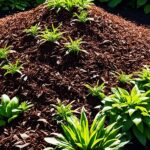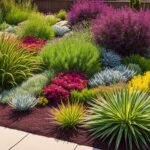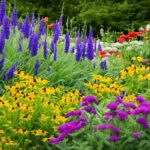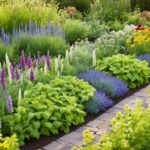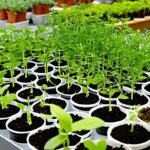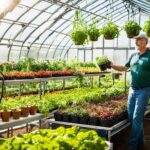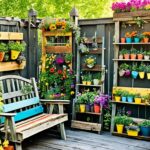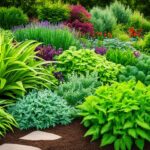Uncategorized
The Benefits of Mulching and How to Apply It Correctly
Have you ever thought about the power of mulch? It’s more than just pretty to look at. Mulch can change your garden for the better, making it more beautiful and productive. We’ll show you how mulching can help with weed control, keep soil moist, and boost your garden’s health and look.
Get ready to see the magic of mulching and learn how to use it right for the best results.
Key Takeaways
- Mulching reduces weed growth, keeping your garden neat and tidy.
- Mulch helps retain soil moisture, reducing the need for frequent watering.
- Applying mulch regulates soil temperature, protecting plant roots from extreme heat or cold.
- Mulching improves soil structure and overall health, supporting the growth of healthy plants.
- Mulch can enhance the curb appeal of your outdoor spaces, adding a finishing touch of elegance.
But did you know the right way to apply mulch is key to its benefits? Learn the best techniques to make your garden flourish with mulching. Find out more in the next sections and turn your outdoor space into a beautiful, sustainable oasis.
What is Mulching?
Mulching is a way to protect soil by adding a layer of material on top. This layer, called mulch, comes from different sources. Organic mulch materials like wood chips and leaves help soil health as they break down. Inorganic mulch such as gravel lasts longer and needs less upkeep.
Definition and Types of Mulch
Mulch is any material spread on soil to protect it. It helps control weeds and keeps soil moist. Knowing the types of mulch helps pick the best one for your garden.
There are two main kinds of mulch:
- Organic mulch: Comes from things like wood chips and leaves. These materials add nutrients to the soil as they decompose.
- Inorganic mulch: Includes materials like gravel and rubber. These types of mulch last a long time and are easy to care for.
Choosing between organic and inorganic mulch depends on your garden’s needs and your preferences. Knowing the differences between types of mulch helps you make the right choice for your garden.
Mulching Reduces Weed Growth
Mulching is great for stopping weeds in your garden. It puts a barrier that blocks sunlight and smothers weed seeds. This means you spend less time pulling weeds and can enjoy gardening more.
Keeping a 2-4 inch layer of mulch helps keep weeds away and helps your plants grow well. It acts as a weed barrier, stopping weed seeds from getting the sunlight and warmth they need. This stops weed germination and cuts down on weeds in your garden.
Mulch also stops weed roots from getting through, making it hard for weeds to survive. This mix of physical and environmental barriers makes mulching a strong way to keep your garden weed-free.
“Mulching is one of the most effective ways to control weeds in a garden. The layer of mulch blocks sunlight and smothers weed seeds, preventing them from germinating.”
Adding mulching to your gardening routine cuts down on the work needed for weed control. You get a beautiful, easy-to-maintain garden with less effort.
Moisture Retention and Water Conservation
Water conservation is key for a lush, vibrant garden. Mulch is a great tool for this. It covers the soil, reducing evaporation and keeping moisture in the soil longer. This means you water your plants less often, saving time, money, and resources.
The type of mulch you use matters for water saving. Coarser mulches like wood chips or pine bark let water soak into the soil easily. Finer mulches, such as shredded leaves or compost, create a barrier that stops water from running off. Choosing the right mulch can make your garden more water-efficient and keep your plants healthy.
How Mulch Helps Retain Soil Moisture
Mulch acts as a shield, protecting the soil from the sun and wind. This slows down evaporation, keeping moisture in the soil for your plants. With higher soil moisture, you water less often, saving water and supporting drought-tolerant gardening.
| Mulch Type | Water Penetration | Evaporation Reduction |
|---|---|---|
| Coarse (Wood Chips, Pine Bark) | High | Moderate |
| Fine (Shredded Leaves, Compost) | Moderate | High |
Adding mulch to your garden can change the game for water use. By picking the right mulch and applying it right, you get a lush garden with less water use. This also helps your soil stay healthy over time.
“Mulch is a gardener’s secret weapon for water conservation. It’s a simple, yet highly effective way to keep your plants hydrated and your water bills low.”
Regulates Soil Temperature
Mulch is a key tool for keeping your soil at the right temperature. It acts like insulation, keeping the soil at a good temperature for your plants all year.
In summer, mulch keeps the soil cool, protecting your plants’ roots from the heat. This is especially important for young plants that can’t handle big temperature changes.
In winter, mulch keeps the soil warm, protecting your plants from frost. It stops sudden drops in temperature, keeping your plants’ roots safe and warm.
Mulch makes a great environment for your plants to grow. It helps with root growth and keeps your plants healthy. Mulch is a big help in keeping your soil temperature right, whether it’s hot or cold.
“Mulch is like a cozy blanket for your soil, protecting it from the harsh extremes of nature.”
Mulch keeps the soil temperature steady, helping your plants grow strong. This is key for gardening success. A layer of mulch can really improve your plants’ health and growth.
Improves Soil Health and Structure
Choosing organic mulches like wood chips or leaves does more than make your garden look good. It also boosts the health and structure of your soil. As these mulches decompose over time, they add important soil organic matter. This is key for soil fertility.
This process helps the soil microbiome grow. This includes microorganisms and earthworms that are crucial for nutrient cycling and soil structure.
The decomposing mulch also makes the soil better for water and roots. It helps plants grow strong and healthy. By using mulch, you’re making your garden’s soil healthier and more productive over time.
| Benefits of Mulching for Soil Health | Impact |
|---|---|
| Increases soil organic matter | Enhances soil fertility and structure |
| Encourages beneficial soil microorganisms | Improves nutrient cycling and soil aggregation |
| Promotes better water infiltration and root penetration | Supports overall plant health and growth |
Adding mulch to your garden does more than make it look nice. It’s a way to invest in your soil’s health and productivity. This simple step can change your garden, making it a place for healthy plants and a beautiful outdoor space.
“Healthy soil is the foundation for productive, sustainable agriculture.” – USDA Natural Resources Conservation Service
Prevents Erosion and Compaction
Mulching is key to a healthy garden. It fights the bad effects of soil erosion and soil compaction. Mulch covers the soil, protecting it from wind, rain, and foot traffic.
Mulch absorbs raindrops, slowing down water runoff. This lets the soil soak up moisture better. It lowers the chance of soil erosion and keeps the soil’s structure right, stopping it from getting hard and compacted.
In busy spots, mulch is a must for protecting soil structure. It acts as a shock absorber, stopping the soil from getting packed down by people or machines. This helps roots grow strong and plants stay healthy, making your garden better.
Adding mulch to your garden is a smart move for its long-term health and productivity. It keeps your soil safe from erosion and compaction. This means your garden will stay lively and support your plants for many years.
Learn more about mulching and how it keeps your soil fertile and safe.
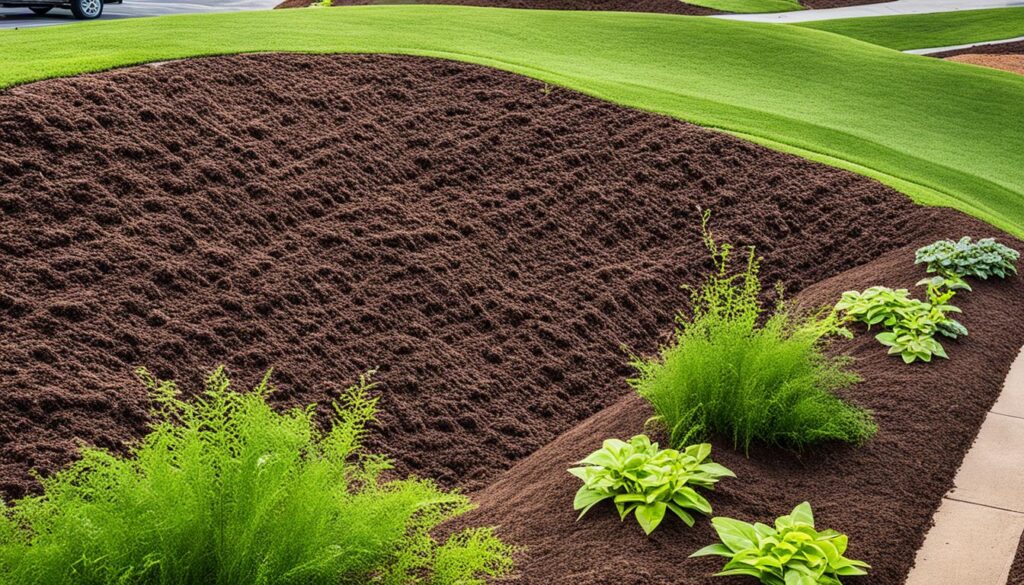
“Mulch is a garden’s best friend, shielding soil from the elements and nurturing its structure for healthier, more vigorous plants.”
| Benefit | Impact |
|---|---|
| Prevents Soil Erosion | Mulch acts as a protective layer, absorbing the impact of raindrops and slowing down water runoff, allowing the soil to absorb moisture more effectively. |
| Combats Soil Compaction | The mulch cushions the soil surface, preventing it from becoming hard-packed and compacted, especially in high-traffic areas. |
| Maintains Soil Structure | By preserving the soil’s porous structure, mulch supports healthy root growth and overall plant vigor. |
Enhances Curb Appeal
Mulching is more than just a garden solution; it boosts your outdoor spaces’ aesthetic appeal. The color and texture of mulch make garden beds, pathways, and plantings look better. It gives them a polished, professional look. Colored mulches, like red or black, match your home’s colors and garden plants.
Mulch is a finishing touch for your landscape design. It makes your property look well-kept and inviting. This is great if you’re selling your home, as a nice exterior makes a good first impression on buyers.
Adding mulch to your landscape design is a smart move. It makes your outdoor space look better and can increase your property’s value. Mulch helps create a aesthetically pleasing look that highlights your property’s best features.
“Mulch is the unsung hero of the garden – it quietly enhances the aesthetic appeal of your outdoor spaces while also providing a host of practical benefits.”
mulching Techniques
Proper mulch application is crucial for your garden’s success. By following simple steps, you can help your plants flourish and keep your landscape looking great.
Preparing the Soil for Mulch
Start by clearing the area of weeds, debris, or dead plants. This makes a clean space for the mulch to work well. Then, water the soil well so it absorbs the moisture fully.
This step helps the mulch last longer and work better.
Applying the Mulch
With the soil prepared, it’s time to add mulch. Aim for a depth of 2-4 inches, but don’t let it touch plant stems or trunks. Spread it evenly, making a doughnut shape around each plant for air and water flow.
Don’t pile mulch too high to avoid pest or disease problems. Keep the layer at the right depth and add more as needed.
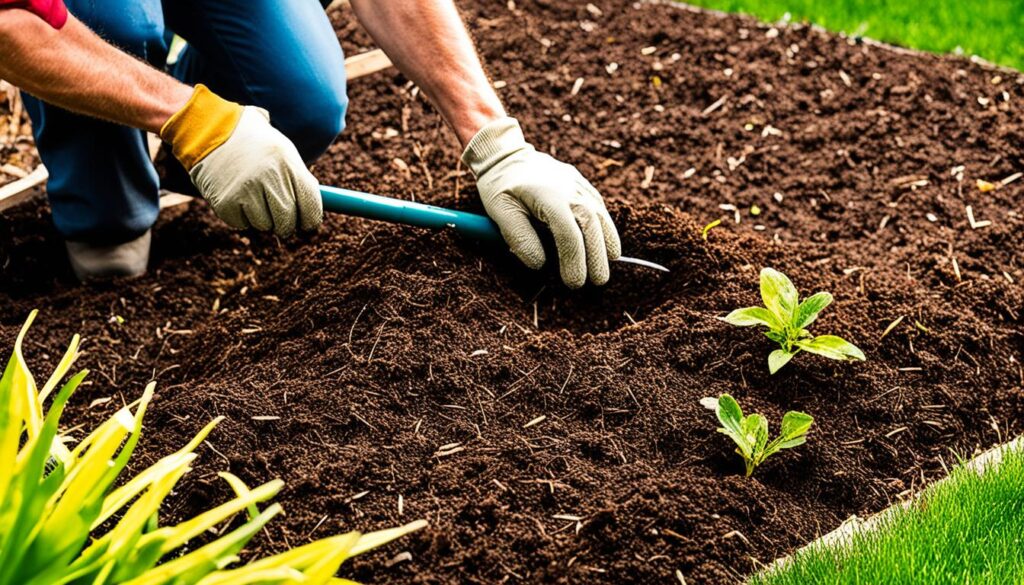
“Proper mulch application is the key to unlocking the full benefits of this garden essential.”
By following these best practices for mulch application, mulch depth, soil preparation, and mulch coverage, you’ll make your mulching efforts more effective. This supports your garden’s health and beauty.
Conclusion
Mulching changes your outdoor areas into lush, easy-to-care-for spots. It makes your garden healthier and more beautiful. By using mulch, you can fight weeds, keep soil moist, control temperature, improve soil, and stop erosion.
Choosing between organic or inorganic mulch is important. It’s all about using it right and picking the best type for your garden. Mulching can take your gardening to the next level, making it more sustainable.
Start using mulching to make your garden thrive with less work. Begin your journey to a sustainable garden. Enjoy a beautiful outdoor space that connects you with nature and boosts your pride in your home.
FAQ
What is mulching and what are the different types of mulch materials?
Mulching is adding a protective layer on top of your garden soil. This layer is called mulch. It can be organic (like wood chips or leaves) or inorganic (like gravel or rubber). Organic mulches improve soil health as they break down. Inorganic mulches last longer and need less upkeep.
How does mulching help reduce weed growth?
Mulch acts as a barrier, blocking sunlight and weed seeds. This stops weeds from growing. You’ll spend less time pulling weeds, letting you enjoy gardening more.
How does mulch help retain soil moisture and conserve water?
Mulch covers the soil, reducing evaporation. This keeps soil moist longer. You’ll water your plants less, saving time, money, and resources.
How does mulch regulate soil temperature?
Mulch insulates the soil, keeping it cool in summer and warm in winter. It protects roots from heat and frost damage.
How does mulch improve soil health and structure?
Organic mulches like wood chips add nutrients and matter to the soil as they break down. This makes the soil richer and improves its structure and health.
How does mulch prevent erosion and soil compaction?
Mulch protects soil from wind, rain, and foot traffic damage. It cushions the soil, preventing erosion and compaction. This supports healthy root growth and plant health.
How can mulching enhance the aesthetic appeal of a garden?
Mulch’s rich color and texture improve garden beds and pathways. It gives your landscape a polished look, making it inviting and well-maintained.
How do you properly apply mulch in the garden?
Clear the area of weeds and debris, then water the soil well. Put down a 2-4 inch layer of mulch, avoiding plant stems. Spread it evenly, leaving space around plants for air and water. Add more mulch as needed to keep it at the right depth.
Source Links
- https://www.homedepot.com/c/ai/benefits-of-mulch/9ba683603be9fa5395fab901dfafd55 – Benefits of Mulch
- https://scotts.com/en-us/lawn-care-101/the-benefits-of-mulching-how-to-pick-the-right-type-of-mulch-material.html – The Benefits of Mulching & How to Pick the Right Type of Mulch Material
- https://homesteadersofamerica.com/8-benefits-of-mulch-in-the-garden/ – 8 Benefits of Mulch in the Garden – Homesteaders of America
Gardening for Climate Change Resilience
How can your garden stand strong against climate change? Learn how to make your garden a symbol of resilience. Discover the power of climate-resilient gardening. Turn your outdoor space into a sustainable haven that can face any challenge.
Key Takeaways
- Adapt your garden to the challenges of climate change through sustainable practices
- Reduce your carbon footprint by embracing eco-friendly gardening techniques
- Enhance soil health and plant diversity to create a resilient, self-sustaining ecosystem
- Conserve precious water resources and harness the power of nature to manage stormwater
- Grow local, heat-tolerant crops to build food security and minimize waste
Understanding Climate-Resilient Gardening
As the climate changes, gardeners need to adapt. They must create climate-resilient and sustainable landscapes that can handle variable weather and extreme events. Climate-resilient gardening is about making gardens that can survive a climate-friendly future.
What is Climate-Resilient Gardening?
Climate-resilient gardening is about making gardens better at adapting and recovering from climate change. It means dealing with more heatwaves, unpredictable rain, and “false springs” that harm plants. By using sustainable methods, gardeners can make green spaces that are ready for a changing climate.
Impacts of Climate Change on Gardening
Climate change brings new challenges to gardeners, such as:
- More heatwaves, droughts, and heavy rains
- Changes in plant hardiness zones, making some plants hard to grow
- Disruptions to pollinators and new pests
- Higher risk of plant diseases and damage from extreme weather
To overcome these problems, gardeners should use climate-resilient gardening methods. These help their gardens do well even with the changing weather.
Reducing Carbon Footprint in Gardening
Gardeners can make a big difference by cutting down on their carbon footprint. Switching to electric or manual garden tools is a great step. These tools don’t just reduce greenhouse gas emissions. They also make gardening quieter and cleaner.
Another good move is to reduce the size of our lawns and try lawn alternatives. Big lawns need a lot of mowing, which uses more fuel and fertilizers. These things add to greenhouse gas emissions. By using less lawn and adding diverse, tough plants, we can cut down on mowing and fertilizer. This makes our gardens more sustainable.
Using Electric or Manual Garden Tools
- Switch from gas-powered to electric or manual garden tools, like mowers and trimmers, to reduce greenhouse gas emissions.
- Electric tools are quieter and use less energy than gas ones.
- Manual tools, like push mowers and hand trimmers, are a low-carbon choice. They also help you get a workout while you garden.
Reducing Lawn Area and Fertilizer Use
- Look at your lawn and think about reducing its size. You could replace it with drought-tolerant plants, groundcovers, or even vegetable gardens.
- Use less fertilizers because they can harm the environment.
- Try organic gardening methods, like composting, to make your soil better. This cuts down on the need for synthetic fertilizers.
By making these changes, we canreduce our carbon footprint. This helps make our gardens and the planet more sustainable.
Planting for Energy Conservation
Adding energy-efficient landscaping to your garden can save a lot of energy and help fight climate change. Planting trees smartly around your home is a key strategy.
Benefits of Planting Trees
Trees act like natural air conditioners, shading buildings and cutting cooling costs. Shade trees can make indoor temperatures drop by up to 20 degrees Fahrenheit. This can save you up to 50% on air conditioning bills.
Evergreen trees also help by blocking cold winter winds, lowering heating costs. They protect your home from harsh winds, keeping you cozy inside.
Trees are great for fighting climate change too. They take in and store carbon dioxide, which helps reduce greenhouse gases. This action helps slow global warming.
Strategic Tree Placement for Shade and Wind Protection
- Plant deciduous trees on the south and west sides to cool your home in summer.
- Put evergreen trees or shrubs on the north and west sides to block cold winter winds.
- Don’t plant trees too close to your home to prevent damage to foundations and structures.
By planting trees thoughtfully, you can cut your energy use and help fight climate change. Trees do more than just save you money; they help the planet too. This makes tree planting a smart choice for your wallet and the earth.
“Planting trees is one of the simplest and most effective ways for individuals to combat climate change and create more resilient communities.”
Increasing Plant Diversity with Natives
Starting a climate-resilient landscape means using native plants. These plants are key to a healthy ecosystem. They feed and shelter local wildlife, like pollinators and beneficial insects.
The Importance of Native Plants
Native plants are made for the local climate and soil. They need less care and water. These plants help keep ecosystems balanced by giving food and shelter to many species. Using native plants in your garden makes it look great and helps the environment.
Avoiding Invasive Plant Species
It’s tempting to add exotic plants, but think of the risks. Invasive plants can harm native ones, reducing plant diversity. They spread fast, taking over and leaving less food and homes for wildlife. Choose native plants and skip invasive species to make a climate-resilient and pollinator-friendly garden.
“Diversity is the spice of life, and in the garden, it’s the key to creating a thriving, climate-resilient ecosystem.” – Jane Doe, Ecological Landscape Designer
Protecting and Improving Soil Health
Healthy, well-structured soil is key for a climate-resilient garden. By reducing soil disturbance and adding organic matter, gardeners help the underground microorganisms. These microorganisms are key for sequestering carbon and improving soil fertility.
Minimizing Soil Disturbance
No-till gardening is a big win for soil health. It avoids tilling or turning the soil. This keeps the soil’s web of life safe, including fungi, bacteria, and earthworms.
This approach keeps the soil’s structure and its ability to store carbon. It makes plants more resilient to drought and extreme weather.
Adding Organic Matter and Composting
Adding nutrient-rich organic matter like compost and mulch boosts soil health and fertility. Composting yard waste and food scraps creates this valuable resource. It also cuts down on landfill waste, reducing methane production.
| Benefits of Organic Matter | Benefits of No-Till Gardening |
|---|---|
|
|
“Soil is the foundation of life. Without healthy soil, we cannot have healthy plants, animals, or people.”
Managing Stormwater and Water Conservation
Climate change means more rain and intense storms. Gardeners can help by managing stormwater and saving water. Using rain gardens, swales, and rain barrels are great ways to do this.
Rain Gardens and Swales
Rain gardens and swales slow down rainwater, spreading it out and letting it soak in. They reduce runoff and erosion. These features also help the local ecosystem by recharging groundwater and easing the load on stormwater systems.
Using Rain Barrels
- Rain barrels catch and store rainwater for watering plants when it’s dry.
- They collect water from downspouts, making them a dependable water source for gardens. This reduces the need for municipal water and lowers your bills.
- Adding rain barrels to your garden design helps during droughts. It ensures your plants stay healthy, even with changing weather.
These methods make gardens more resilient to extreme weather. By using them, you support stormwater management and water conservation. Your garden will flourish, even with a changing climate.
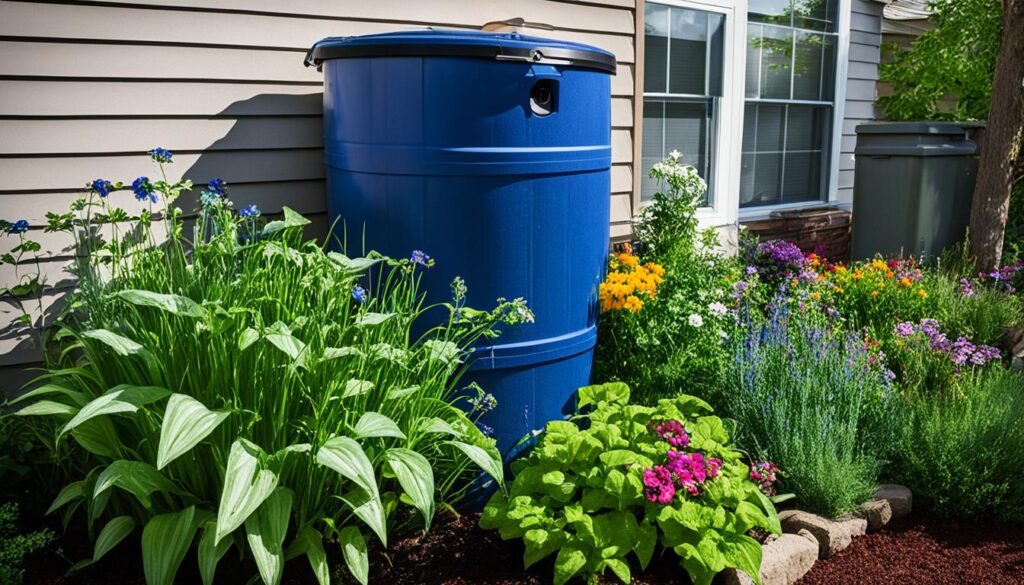
Growing Food Locally and Reducing Waste
As a gardener, you play a key role in making our climate more resilient. By growing your own food and cutting down on waste, you help a lot. Starting a vegetable garden, even in small spaces, can give you fresh, local produce. It also reduces the harm from transporting and storing food over long distances. As the climate changes, picking crops that can handle the heat is vital for climate-resilient food systems.
Starting a Vegetable Garden
Growing your own veggies, herbs, and fruits is rewarding and helps the planet. You can do this even with a small balcony or big backyard. By growing your own food, you enjoy fresh taste and help reduce the environmental damage from big food systems.
Heat-Tolerant Crops and Cultivars
With the climate changing, choosing heat-tolerant crops and cultivars is key. This means picking plants like tomatoes, peppers, and eggplants that can handle the heat. These plants make sure you have a good harvest even when the weather gets tough.
Reducing food waste is also vital for a sustainable and climate-resilient food system. Food waste in landfills creates methane, a strong greenhouse gas. So, cutting down on food waste can greatly reduce your carbon footprint.
| Crops | Heat-Tolerant Cultivars |
|---|---|
| Tomatoes | Sun Gold, Cherokee Purple, Mortgage Lifter |
| Peppers | Numex Conquistador, Keystone Resistant Giant, Ancho Ranchero |
| Eggplants | Black Beauty, Fairytale, Listada de Gandia |
“Growing your own food is one of the most empowering and climate-friendly actions you can take as a gardener.” – [Expert Gardener]
climate-resilient gardening Techniques
As the climate changes, we must adapt our gardening to be resilient and sustainable. Two key techniques can help your garden do well with climate change. These are no-till gardening and continuous planting with cover crops.
No-Till Gardening
No-till gardening changes the game for soil health and carbon sequestration. By not tilling, you keep the underground networks of microorganisms alive. These microorganisms help store carbon in the soil. This helps fight climate change and makes your plants healthier.
Continuous Planting and Cover Crops
Having something always growing in your garden is a smart move. Use cover crops like clover, rye, and vetch to protect the soil and add nutrients. They help your garden capture and hold carbon. This way, your garden stays resilient and productive, even with climate changes.
Using regenerative gardening practices can turn your garden into a thriving oasis. It feeds you and helps our planet. Try no-till gardening and continuous planting to make your garden climate-resilient.
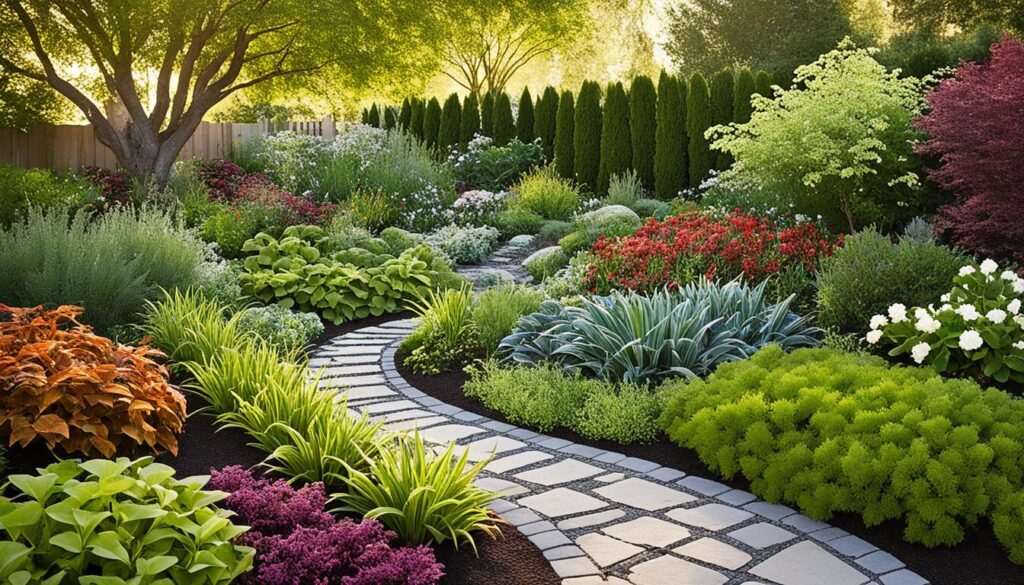
| Technique | Benefits |
|---|---|
| No-Till Gardening |
|
| Continuous Planting with Cover Crops |
|
“Regenerative gardening practices work in harmony with natural processes to create more resilient, productive, and sustainable gardens that can better withstand the challenges of a changing climate.”
Creating Microclimates and Habitats
As the climate changes, smart gardeners use natural features and plants to make microclimates and habitats. These protect their plants. By using microclimates, natural features, and native plants, you can make a garden that can handle global warming better.
Using Natural Features for Protection
Shade from trees, windbreaks from slopes, and rocks can help make microclimates in your garden. These natural things can protect your plants from extreme weather. By placing them right, you can make safe spots in your garden.
Incorporating Native Plant Buffers
Native plants are key for boosting biodiversity and making important habitats for wildlife. Adding woodlands, meadows, or hedgerows of native plants helps. These not only protect your garden from harsh weather but also support a healthy ecosystem.
Using microclimates, natural features, and native plants turns your garden into a resilient oasis. It not only survives climate changes but also supports lots of wildlife.
Conclusion
Embracing climate-resilient gardening can turn your garden into a thriving oasis. It helps reduce your carbon footprint, improve soil health, and increase plant diversity. These efforts can make a big difference in creating resilient landscapes.
Strategic tree placement and using native plants are key. They help manage stormwater and make your garden more productive and enjoyable. This approach not only benefits your garden but also helps your community and the planet adapt to climate change.
As you garden, be proud of your role in creating resilient landscapes. Sharing your knowledge can inspire others to garden sustainably. Together, we can shape a greener, more sustainable world for the future.
FAQ
What is climate-resilient gardening?
Climate-resilient gardening helps gardens adapt and recover from climate change effects. This includes extreme weather like heatwaves and floods. It uses sustainable practices to reduce greenhouse gases and keep gardens healthy in changing conditions.
How can gardeners reduce their carbon footprint?
Gardeners can cut their carbon footprint by using electric or manual tools instead of gas ones. They can also make lawns smaller and use organic gardening to cut down on fertilizers.
What are the benefits of planting trees in the garden?
Trees offer many benefits like shading buildings and protecting against cold winds. They also take in carbon dioxide, helping to fight climate change. Maryland aims to plant 5 million native trees by 2031 to fight climate change effects.
Why is it important to incorporate native plants in the garden?
Native plants fit well with local conditions and need less water and care. They feed and shelter native wildlife, like pollinators, which are key to a healthy ecosystem as the climate changes.
How can gardeners improve soil health and increase carbon sequestration?
Gardeners can use no-till gardening and continuous planting to help soil capture and hold carbon. Adding things like compost and mulch also boosts soil health and water retention.
What are some strategies for managing stormwater and conserving water in the garden?
Using rain gardens and swales can slow down rainwater and prevent runoff. Storing rainwater in barrels is another way to save water, especially during dry times.
How can gardeners build climate resilience by growing their own food?
Growing a vegetable garden provides fresh produce and cuts down on food transport emissions. Choosing heat-resistant crops helps gardens survive in warmer conditions.
Source Links
- https://extension.umd.edu/resource/sustainable-gardening-solutions-climate-change – Sustainable Gardening: Solutions to Climate Change
- https://extension.umd.edu/programs/environment-natural-resources/program-areas/home-and-garden-information-center/gardening-resources/climate-resilient-gardening – Climate-Resilient Gardening | University of Maryland Extension
- https://bcfarmsandfood.com/grow-climate-change-resilient-garden/ – Grow a Climate Change Resilient Garden – BC Farms & Food
Sustainable Harvesting Practices: Enjoy Your Garden’s Bounty
Have you ever had too much fresh produce from your garden and didn’t know what to do with it? Sustainable harvesting practices can help you enjoy your garden’s harvest while helping the environment and your community. We’ll look into sustainable harvesting, its benefits, and how to do it right.
Key Takeaways
- Discover the importance of sustainable harvesting practices for your garden
- Learn how to plan and time your harvest for maximum efficiency
- Explore eco-friendly preservation methods to enjoy your garden’s bounty year-round
- Discover how to share your surplus produce with your community
- Gain insights on how to incorporate sustainable practices into your garden planning for the next season
Are you ready to unlock the full potential of your garden and contribute to a more sustainable future? Let’s dive in and explore the art of sustainable harvesting practices together.
The Importance of Sustainable Harvesting
Adopting sustainable gardening is crucial for your garden’s health and the planet’s. Using organic methods and skipping synthetic fertilizers and pesticides helps. This approach boosts soil quality, cuts down on greenhouse gases, and lessens harmful runoff. It’s good for the earth and encourages eating more fruits and vegetables.
It also means using fewer single-use plastics, helping us move towards a sustainable future.
Benefits of Sustainable Harvesting
Sustainable gardening and harvesting bring many benefits, such as:
- Better soil health and fertility with organic additives
- Less pollution and greenhouse gases by avoiding synthetic chemicals
- Healthier eating for families with more fresh, homegrown produce
- Less need for single-use plastics, supporting eco-friendly food storage and preserving garden produce
By choosing these sustainable ways, you get to enjoy your garden’s bounty and help make a greener, healthier future for everyone.
“Sustainable gardening is not just a hobby; it’s a way of life that benefits both our personal health and the health of the environment.”
Planning Your Harvest
Successful garden planning is crucial for a great sustainable gardening harvest. Think about when different crops ripen, the best ways to pick them, and how to preserve and store your crop storage. Using clean tools and containers helps keep your harvest fresh longer.
Try succession planting to have a steady harvest instead of too much at once. This way, you can enjoy your garden’s produce all season, not just in one big batch.
- Plan for the ripening times of different crops
- Determine the best harvesting techniques for each type of produce
- Consider how you will preserve and store your garden’s yield
- Utilize succession planting for a steady, manageable harvest
“Careful planning is the foundation of a successful, sustainable harvest.”
By planning your garden planning and sustainable gardening well, you can make the most of your garden’s produce. You’ll waste less and enjoy more. The planning you do now will reward you with delicious harvests later.
Harvesting Techniques
Timing is Key
Timing is crucial when it comes to harvesting tips. Each crop has its own signs of readiness, like color, size, and texture. Knowing when to pick your crops is key to getting the best taste and quality.
It’s also vital to handle your harvested crops carefully. Clean tools and containers help keep them fresh and nutritious. Also, think about the storage conditions like temperature and humidity to keep your crops in top shape.
Learning the best ways to harvest and when can make your sustainable gardening efforts rewarding. You’ll get to enjoy tasty, organic practices-based food from your garden.
“Timing is the most important factor in harvesting your garden’s crops. Get it right, and you’ll be rewarded with the best possible flavor and nutrition.”
For successful crop storage and preserving garden produce, pay attention to each crop’s needs. With a bit of care, you can enjoy your garden’s bounty for many months.
Preserving Your Harvest
As your garden’s produce fills your shelves, it’s time to think about preserving it. You can use canning, freezing, drying, fermenting, and pickling to keep your garden’s treasures fresh. Each method has its own benefits and affects the flavor and nutrition of your food.
Using the right storage and preservation methods can reduce food waste. It also lets you enjoy your garden’s bounty all year. Let’s look at the different ways to keep your crop storage, garden produce, and food preservation options.
Canning for Long-Term Storage
Canning is a classic way to preserve garden produce. It seals in freshness and flavor, making jars of your favorite foods. You can make everything from tomato sauce to pickled peppers using canning.
Freezing for Quick Access
Freezing is a simple way to preserve food. It keeps most of the nutrients of your fresh produce. Blanching veggies before freezing helps keep their texture and color. Fruits can be frozen whole or turned into smoothies and baked goods.
Drying for Concentrated Flavor
Drying is great for preserving garden produce. You can dry herbs, spices, sliced fruits, and veggies using a dehydrator or your oven. Dried produce is compact and adds a burst of fresh flavor to your cooking all year.
| Preservation Method | Benefits | Considerations |
|---|---|---|
| Canning | – Shelf-stable storage – Retains flavor and nutrients – Versatile for various produce |
– Requires specialized equipment – Time-consuming process – Potential for food safety risks |
| Freezing | – Quick and easy – Preserves texture and color – Retains nutritional value |
– Limited storage space – Potential for freezer burn |
| Drying | – Compact storage – Concentrates flavors – Versatile for many produce types |
– Requires specialized equipment – Longer processing time |
Choosing to can, freeze, or dry your garden’s produce depends on what you prefer and need. With some planning and effort, you can enjoy the crop storage and food preservation benefits of your garden planning all year.
Sustainable Harvesting
Organic Pest Control Methods
Sustainable harvesting is more than just picking crops. It’s about making your garden work well and being kind to the planet. Using organic practices, like planting friends together, bringing in good bugs, and using safe repellents, keeps your garden healthy. This way, you don’t need bad chemicals.
These green methods are good for the earth and keep your food safe to eat. By choosing sustainable gardening, you make a garden that works well with nature. It’s all about garden efficiency.
- Companion planting: Putting plants together to keep pests away and draw in good bugs.
- Introducing beneficial insects: Letting helpful insects, like ladybugs and lacewings, eat the bad bugs.
- Using natural repellents: Spraying or dusting with things like garlic, herbs, or essential oils to keep pests away.
“Sustainable harvesting is not just about the act of harvesting itself, but a holistic approach that considers the long-term health and balance of the entire ecosystem.”
With organic practices, your garden will be healthy and strong without harmful chemicals. This is good for the planet and keeps your food safe and tasty. You can enjoy your garden’s fruits and veggies without worrying about the impact on the earth.
Sharing Your Bounty
Sustainable gardening is more than just growing a garden. It’s about sharing what you grow with your community. By giving extra produce to food banks, you make sure your hard work helps others. You also make sure people get fresh, healthy food they might not have otherwise.
Groups like Each Green Corner and the University of California Master Gardeners Harvest for Neighbors project help gardeners and those in need. They connect gardeners with people who don’t have enough food. This way, you can help make your community a better place.
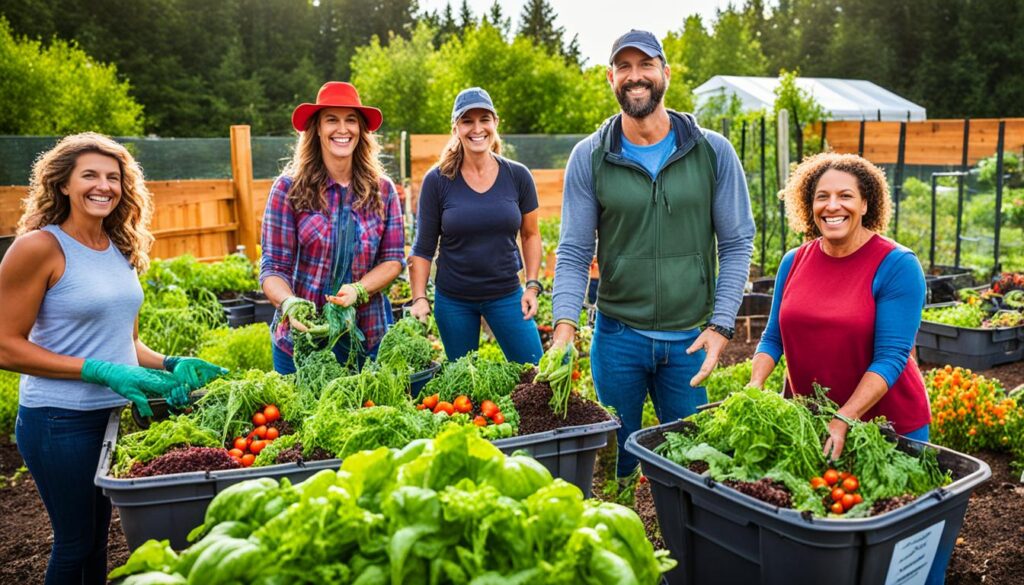
Sharing your garden’s extra food is great for everyone. It cuts down on food waste and brings happiness to those without access to fresh produce. By sharing your garden harvesting tips and sustainable gardening advice, you encourage others to help build a better food system.
The Power of Community Involvement
Being part of your community is key to sustainable food preservation and community involvement. You could help at a community garden, swap produce with neighbors, or plan a harvest festival. These actions bring people together and make us all care more about our food.
“When we come together to share our garden’s bounty, we’re not just nourishing bodies – we’re nourishing the spirit of our community.”
| Organization | Mission | How to Get Involved |
|---|---|---|
| Each Green Corner | Connecting home gardeners with food-insecure families | Donate excess produce, volunteer, or start a local chapter |
| University of California Master Gardeners Harvest for Neighbors | Harvesting and distributing surplus produce to food banks and shelters | Contact your local UC Master Gardener program to volunteer |
Sharing and getting involved in your community can really change lives. So, when your garden is full of food, think about giving some away. You’ll feel the happiness of helping others.
Garden Planning for Next Season
As the growing season ends, it’s key to plan for next year. Clean up plant debris, mulch the soil, and think about planting a cover crop to boost soil health. Looking back at this season helps you make better choices for next year, like picking the right crops and when to plant them.
Improving your gardening habits makes for a better harvest every year. Here are some tips to start:
- Check how your garden did this year. See which crops did well and which didn’t. This info helps with planning next year.
- Think about crop rotation. Switching crops helps prevent soil problems and keeps pests and diseases away.
- Try new varieties: Grow different types of your favorite veggies or add new ones to your garden.
- Plan how to store and preserve your harvest. This way, you can enjoy your garden’s produce all year.
- Use cover crops: Plant them in empty spots to make the soil better, richer, and keep it moist.
Planning ahead sets your garden up for success. This way, you can keep enjoying your garden’s rewards for many years.
| Crop | Recommended Planting Time | Preservation Method |
|---|---|---|
| Tomatoes | May-June | Canning, Freezing |
| Carrots | April-June | Root Cellar Storage |
| Spinach | March-April, September-October | Freezing |
“Successful gardening is not just about what you grow, but how you plan for the future. Take the time to learn from your past experiences and make adjustments for an even more bountiful harvest next season.”
Remember, garden planning is a continuous process. By refining your approach, you can have a sustainable, thriving garden. This way, you’ll always have fresh, nutritious produce.
Community Involvement
Sustainable gardening is more than just about your garden. It’s about building a community around your green practices. By connecting with your local community, you can make a bigger difference. You can also encourage others to grow food in eco-friendly ways.
Start by joining or leading community events like garden workdays, produce swaps, or workshops. These events let you share tips, learn from others, and meet people who care about the planet. Working with groups like food banks, schools, or community centers can help you give away extra food and teach others about preserving food sustainably.
- Organize or join community garden workdays
- Host or go to produce swaps to share your harvest
- Give workshops on sustainable gardening and food preservation
- Donate extra produce to local food banks or community programs
- Work with schools or community centers to inspire future sustainable gardeners
Building a community of sustainable gardeners helps spread the word and make a bigger difference. Your garden can bring people together, improve food access, and increase love for local food systems.
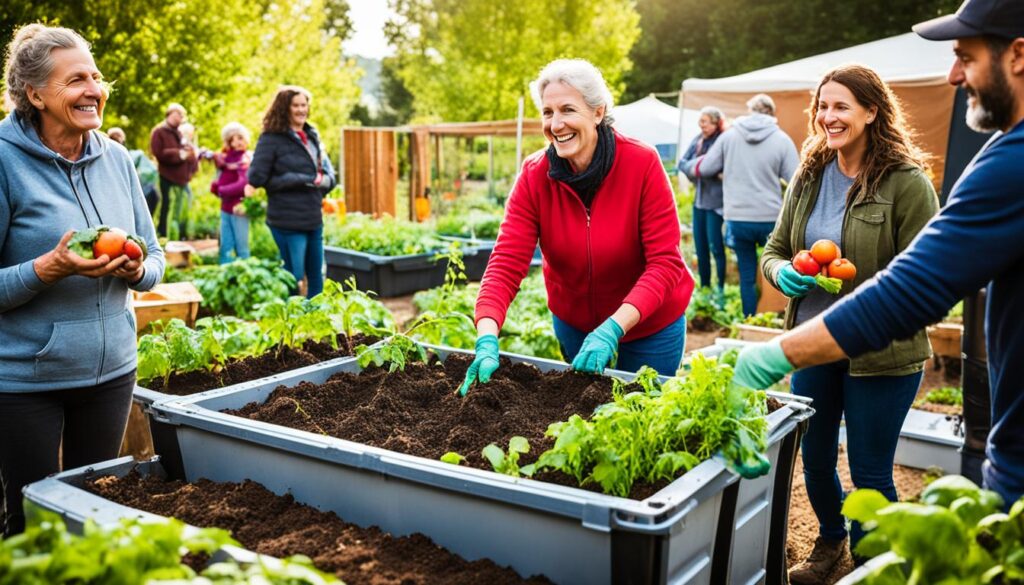
“Sustainable gardening is not just about the plants – it’s about growing a community rooted in shared values and a commitment to the environment.”
Conclusion
Sustainable harvesting is the secret to making your garden thrive. By planning and using the right techniques, you can enjoy your garden’s produce all year. Sharing your harvest with others also helps spread the joy.
Using organic pest control and cover crops makes your garden even better. It becomes a place that feeds you and helps the local environment. This makes your garden a green haven for everyone.
By gardening sustainably, you get a lot of food and help the planet. Keep up with these practices and watch your garden grow. It will show the beauty of living sustainably and the happiness of growing your own food.
Every step you take in sustainable harvesting counts. Your garden shows what you value. By taking care of it, you’re working towards a better future for your community and Earth. Keep learning, trying new things, and sharing what you know. Your garden’s harvest is a gift that keeps giving.
FAQ
How can I share my garden’s abundance with my community?
Sharing your garden’s produce with others connects you with your community and helps those in need. Donate to local food banks, shelters, or groups like Each Green Corner. They link gardeners with those who lack access to food.
What are some sustainable harvesting practices I can implement in my garden?
Use organic methods and avoid synthetic fertilizers and pesticides. Try companion planting and beneficial insects to keep your garden healthy. Properly store your harvest to reduce waste and keep your produce fresh.
How can I plan for a successful harvest in my garden?
Plan carefully for a great harvest. Think about when crops ripen, how to harvest them, and how to store them. Succession planting can give you a steady harvest instead of a huge amount all at once.
Why is it important to time my harvests correctly?
Harvesting at the right time is key. Each crop has its own signs of readiness, like color or size. Harvesting when they’re ready ensures they taste best. Use clean tools and containers to keep your produce fresh.
What methods can I use to preserve my garden’s bounty?
You can preserve your garden’s produce through canning, freezing, drying, fermenting, or pickling. Each method has its own needs and effects on taste and nutrition. Storing your harvest right can reduce waste and let you enjoy your garden’s produce all year.
How can I incorporate organic pest control methods into my sustainable gardening practices?
Use organic pest control like companion planting, beneficial insects, and natural repellents. These methods keep your garden healthy without harming the environment. They also make sure your food is safe and of high quality.
How can I plan for the next growing season based on the current year’s harvest?
Plan for next year’s garden as the season ends. Clean up, mulch, and maybe plant a cover crop to enrich the soil. Think about what worked and what didn’t this year. This will help you choose better crops and schedules for the future, ensuring a successful harvest every year.
Source Links
- https://fastercapital.com/topics/harvesting-and-preserving-your-gardens-bounty.html – Harvesting And Preserving Your Gardens Bounty – FasterCapital
- https://ucanr.edu/blogs/blogcore/postdetail.cfm?postnum=55146 – Sharing Your Garden Bounty
- https://gradesofgreen.org/program-pathway/launch-eco-lessons/launch-lessons-harvest-and-sustain-your-garden-part-4-of-4-k-5th/ – LAUNCH Lessons: Harvest and Sustain a Garden K-5th Activity
Gardening for Pollinators: Create a Buzz-Worthy Garden
Are you ready to turn your garden into a haven for pollinators? Bees, butterflies, and other beneficial insects are key to our ecosystem. By making your garden pollinator-friendly, you help them and make your garden beautiful and sustainable. Learn how to create a garden that is good for pollinators and looks great.
Key Takeaways
- Understand the importance of pollinators and their role in a healthy ecosystem
- Learn how to choose the right plants to attract a variety of pollinating insects
- Discover organic gardening practices that promote a thriving, pollinator-friendly environment
- Explore strategies for designing a visually appealing and ecologically sound garden layout
- Discover ways to engage your community and inspire others to create pollinator-friendly gardens
Ready to get started? Unlock the secrets to building a garden that buzzes with life and beauty. What unexpected benefits might you discover when your backyard becomes a haven for pollinators?
The Importance of Pollinators
Pollinators like bees, butterflies, moths, and some birds are key to our gardens and the environment. They help pollinate plants, which is crucial for many crops and wild plants to grow. Without them, many plants we need for food, clothes, and medicine would not survive.
Why Pollinators Matter
Creating a pollinator-friendly garden helps these vital species and boosts your garden’s health. It attracts many pollinators, letting you see nature’s beauty up close. This also supports sustainable gardening practices important for our future.
“Pollinators are the unsung heroes of our gardens and agricultural systems. Without them, our world would be much less vibrant, productive, and beautiful.”
A pollinator-friendly garden is more than just pretty. It’s a key part of keeping our ecosystem balanced and supporting the pollinator benefits they offer.
By welcoming pollinators into your garden, you help protect these amazing creatures. This ensures a healthy and biodiverse future for all of us.
Choosing the Right Plants
Starting a pollinator-friendly garden means picking the right plants. You need a mix of flowers that attract different pollinators all season long. Include plants like lavender, borage, bee balm, milkweed, butterfly bush, and salvia to draw bees, butterflies, and hummingbirds.
When planning your garden, mix pollinator-friendly plants that offer nectar and pollen at various times. This keeps your pollinators fed from spring to fall.
- Lavender: Attracts a variety of bees and butterflies with its fragrant purple flowers.
- Borage: A favorite of bees, this plant produces lovely blue star-shaped blooms.
- Bee balm: Also known as Monarda, this plant is a magnet for hummingbirds and butterflies.
- Milkweed: An essential host plant for monarch butterflies, providing food and shelter.
- Butterfly bush: As the name suggests, this shrub is a prime destination for butterflies.
- Salvia: These vibrant flowers are adored by hummingbirds and bees alike.
By picking plants that bees and other pollinators love, you’re on your way to a lively garden. It will be full of life and activity all season.
“A garden is a grand teacher. It teaches patience and careful watchfulness; it teaches industry and thrift; above all it teaches entire trust.” – Gertrude Jekyll
Garden Layout and Design
Creating a pollinator-friendly garden needs careful planning. Focus on key elements to make your outdoor space welcoming for bees, butterflies, hummingbirds, and moths.
Planning Your Garden Layout
Think about what pollinators need when planning your garden. Choose spots that get at least six hours of sunlight a day. This is where many pollinator-friendly plants do well.
Group similar plants together to make your garden look better and be richer in resources for pollinators. Use plants of different heights to offer shelter and food at various levels. Don’t forget to add a water source, like a shallow birdbath, for the pollinators’ moisture needs.
| Garden Design Element | Pollinator-Friendly Considerations |
|---|---|
| Sunlight | Aim for areas that receive at least 6 hours of direct sunlight per day |
| Plant Grouping | Cluster similar plants together to create resource-rich environments |
| Plant Heights | Include a variety of plant heights to provide shelter and foraging opportunities |
| Water Source | Incorporate a shallow birdbath or dripping feature to provide necessary moisture |
Plan your garden with pollinators in mind to make a beautiful, thriving space. This supports the local ecosystem and boosts garden biodiversity.
“A well-designed garden layout is the foundation for a sustainable gardening approach that nurtures a diverse community of pollinators.”
Organic Gardening Practices
To support pollinators and make a garden sustainable, use organic gardening methods. Avoid harmful pesticides and choose natural ways to control pests. This keeps your garden healthy and helps pollinators too.
Organic gardening means using organic mulch and compost. These materials add nutrients to the soil and keep it moist. This creates a healthy soil that draws in many pollinators.
| Organic Gardening Practices | Benefits for Pollinators |
|---|---|
| Natural Pest Control | Protects pollinators from harmful chemicals |
| Organic Mulch and Compost | Enhances soil health and moisture retention |
| Diverse Plant Selection | Provides a variety of food sources for pollinators |
Using sustainable gardening methods makes your garden a great place for pollinators. With eco-friendly gardening, your garden becomes a safe spot for important creatures. They help keep our ecosystems healthy.
“Organic gardening is not only better for the environment, but it also creates a healthier, more vibrant garden that supports pollinators and other beneficial wildlife.”
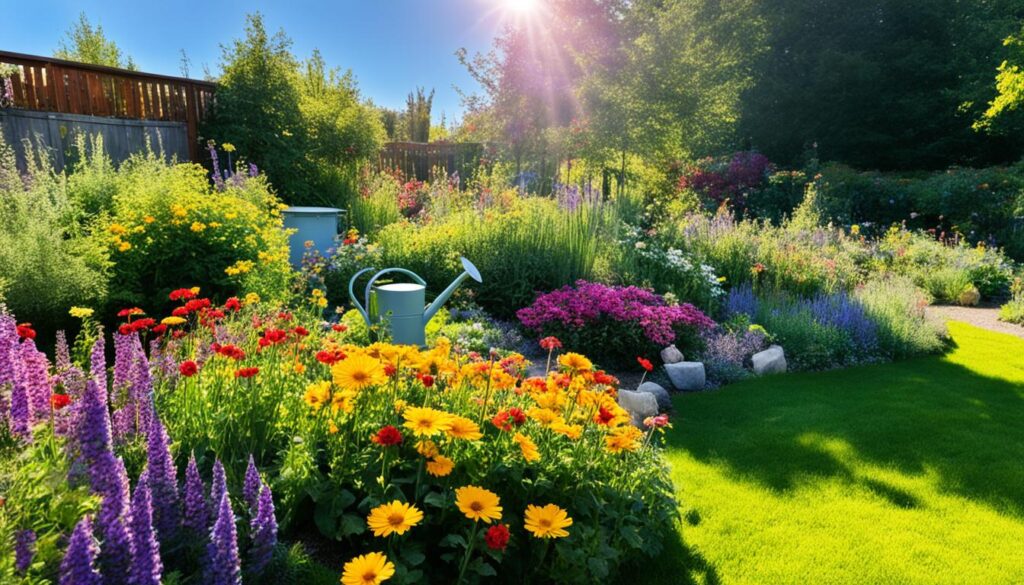
Every step towards organic gardening helps your garden and the environment. Start with sustainable gardening and see your garden become a place where pollinators thrive.
Gardening for Pollinators
Turning your garden into a haven for pollinators is a great way to help the environment and beautify your outdoor space. By adding a mix of flowering plants, offering water and shelter, and skipping pesticides, you can make a garden that bees, butterflies, and other pollinators love. This makes your garden a lively spot for these important insects.
Choosing a variety of pollinator-friendly plants is key to drawing pollinators to your garden. These plants give nectar and pollen to your visitors and boost garden biodiversity. Add native flowers, herbs, and shrubs that bloom at different times to keep food sources steady for pollinators.
Adding water and shelters also makes your garden more inviting for pollinators. A shallow bird bath or a dripping faucet can be a drink spot for bees and butterflies. Leaving some bare soil or creating small rock piles can offer places for them to nest and hide.
Steering clear of pesticides and choosing organic gardening helps make your garden safe for pollinators. Use natural pest control methods like introducing helpful insects or planting companions to keep your garden healthy and balanced.
Creating a pollinator-friendly garden is a fulfilling journey that helps local pollinators and makes your outdoor space more beautiful and lively. With careful choices and sustainable gardening, you can be a guardian of the environment and enjoy a buzz-worthy garden.
Engaging the Community
When it comes to sustainable gardening, garden biodiversity, and eco-friendly practices, the key is engaging your local community. Encouraging your neighbors to start their own pollinator-friendly gardens helps create a network of gardens. This network provides more habitats and resources for pollinators, benefiting their health.
Sharing the importance of gardening for pollinators can make a big difference. By teaching others, you inspire a community commitment to protect our pollinators. This shared effort helps protect our environment.
Think about organizing neighborhood events like plant swaps or workshops. These events teach eco-friendly gardening and the vital role of pollinators. They also build community, as people come together for a good cause.
“When we all do a little, it adds up to a lot. By working together as a community, we can create an abundance of pollinator-friendly gardens and make a lasting difference in the health of our local environment.”
Sustainable gardening is about more than just our actions. It’s about a community mindset that values garden biodiversity and nature. By engaging your community, you inspire a movement that goes beyond your garden, impacting future generations.

Starting Your Pollinator-Friendly Garden
If you have a well-kept lawn, start making it a haven for pollinators by mowing less. Try mowing every 10 days or 2 weeks instead of weekly. This lets native plants grow and gives pollinators nectar and pollen.
Don’t bag up all the leaves and twigs in the fall. These items are important for bees to nest in during the winter. By leaving them, you help these pollinators rest and reproduce.
When planting, choose native plants that draw in many pollinators. Garden planning, sustainable gardening, and eco-friendly gardening help make a pollinator-friendly space in your yard.
“The best time to plant a tree was 20 years ago. The second best time is now.”
This saying is true for garden planning for pollinators. You can’t fix years of manicured lawn, but you can start now. With some time and effort, your yard can become a home for bees, butterflies, and other pollinators.
Overcoming Challenges
Creating a sustainable gardening oasis for pollinators is rewarding but challenging. One big hurdle is fighting against the idea of a perfect, manicured lawn. Consider using signs or keeping a neat area near the sidewalk. This way, you can let the rest of your yard become a diverse, eco-friendly gardening space.
Talking to your neighbors and questioning your own ideas about a “nice” yard can change things. Going for a natural look can help pollinators and save time and resources on lawn care.
- Incorporate visual cues like lawn signs to signal your commitment to a pollinator-friendly garden
- Retain a small, traditionally mowed area near the sidewalk to blend with neighborhood expectations
- Educate your community about the benefits of diverse, sustainable gardening practices
- Challenge your own preconceptions about the “perfect” lawn and embrace a more natural, meadow-like aesthetic
By doing these things, you can beat societal norms and make a great, eco-friendly gardening spot. This spot will help pollinators and make your garden healthier.
“Embracing a natural, meadow-like aesthetic can not only support pollinators but also reduce the time and resources required for traditional lawn maintenance.”
Conclusion
Turning your garden into a haven for pollinators makes it beautiful and helps our vital pollinators. By choosing the right plants and using eco-friendly gardening methods, you help these important creatures. This also supports the health of our ecosystems for the future.
Starting a garden health-focused, pollinator-friendly garden might seem hard, but it’s worth it. Begin today and watch your garden become a place where pollinators and people can live together well.
You have the power to change things. Use this chance to protect our nature and see the beauty when your garden helps these amazing creatures. Be proud of taking care of the earth and encourage others to do the same. This will create a wave of sustainable gardening that helps future generations.
FAQ
What is the key to a successful pollinator garden?
The key is to have diversity in your garden. Plant a mix of flowers to attract different pollinators. This ensures blooms all season long.
What types of plants should I include in my pollinator-friendly garden?
Include plants that bees, butterflies, and hummingbirds love. Think about adding lavender, borage, bee balm, milkweed, butterfly bush, and salvia.
How can I design my garden to make it more inviting and accessible for pollinators?
Aim for areas that get at least six hours of sunlight daily. Group similar plants together and vary their heights. Add water sources like a shallow birdbath for pollinators.
What are some organic gardening practices I can implement to support pollinators?
Avoid harmful pesticides and choose natural pest control. Use organic mulch and compost to keep soil healthy. This helps pollinators without chemicals.
How can I engage my community in creating pollinator-friendly gardens?
Encourage neighbors to make their gardens pollinator-friendly. This creates a network of gardens that help pollinators. By spreading awareness, you can make a big difference.
What is the first step someone with a manicured lawn can take to begin transitioning to a pollinator-friendly yard?
Start by mowing less often. Try mowing every 10 days or 2 weeks instead of weekly. Also, don’t bag all the leaves and twigs in the fall. They provide nesting sites for bees.
How can I address the societal norms and expectations around the “perfect” manicured lawn?
Use signs or keep a neat area near the sidewalk. Educate your neighbors and rethink what a “nice” yard looks like. This can change the way people see gardens.
Source Links
- https://www.brooketully.com/pollinator-yards/ – Workin’ it From Home: Buzz-worthy Backyards < by Brooke Tully
- https://thezebra.org/2024/04/07/creating-a-buzz-how-to-cultivate-a-bee-friendly-garden/ – Creating a Buzz: How to Cultivate a Bee-Friendly Garden
- https://countrybarn.net/2024/05/08/planting-for-pollinators-how-to-create-a-buzz-worthy-garden/ – Planting for Pollinators: How to Create a Buzz-Worthy Garden – The Country Barn
Herbal Gardening: Growing and Using Medicinal and Culinary Herbs
Herbal gardening is a journey that brings together nature and health. Imagine a garden full of medicinal herbs and culinary herbs. These plants can boost your health and add flavor to your food. But starting can seem daunting. How do you create an organic and sustainable garden that meets your needs?
This guide will show you how to grow and use herbs. You’ll learn about planning and caring for an herb garden. It will become a key part of your natural health and wellness routine. Whether you’re new to gardening or have years of experience, this journey into herbal gardening will connect you with nature. It will also help you live a more eco-friendly and self-sufficient lifestyle.
Key Takeaways
- Discover the joys and benefits of growing your own medicinal and culinary herbs
- Learn how to plan and design an herb garden that caters to your family’s health needs
- Explore the versatile uses of essential medicinal herbs like Echinacea and Lavender
- Uncover the hidden health benefits of common culinary herbs
- Adopt sustainable gardening practices for a thriving and eco-friendly herb garden
Defining Your Medicinal Herb Garden Needs
Before starting your medicinal herb garden, think about your family’s health needs. Consider common health issues like colds, flu, digestive problems, skin issues, or stress. This helps you pick the right medicinal herbs for your family.
Assessing Your Family’s Health Requirements
Make a list of health issues you want to tackle with your medicinal herb garden. This might be boosting immunity, fighting infections, easing digestive issues, or helping with stress. Knowing your family’s health needs lets you choose the best herbs for natural remedies.
Choosing Herbs Based on Your Climate and Growing Conditions
After picking the health issues to address, find out which herbs will do well in your area. Some herbs are perfect for certain climates. Think about your local temperature, rainfall, and soil type to pick climate-appropriate herbs that will grow well.
For instance, perennial herbs like lavender and echinacea come back every year. Self-seeding annuals like chamomile and calendula often grow back on their own. Research each herb‘s needs to make a diverse and successful medicinal herb garden.
| Herb | Climate Preference | Growing Conditions |
|---|---|---|
| Lavender | Warm, dry climates | Full sun, well-drained soil |
| Echinacea | Temperate, moist climates | Full sun to partial shade, well-drained soil |
| Chamomile | Mild, sunny climates | Full sun, well-drained soil |
| Calendula | Cool, temperate climates | Full sun, well-drained soil |
Think about your family’s health needs and your area’s growing conditions to make a great medicinal herb garden. This garden will give you the natural remedies you need.
Planning and Designing Your Herb Garden
Starting a medicinal herb garden requires careful planning and design. Think about sunlight exposure, soil quality, and available space to make a herb garden layout that lets each plant grow well. Using companion planting techniques can also help. This approach keeps pests away, draws in pollinators, and creates a balanced garden.
Creating a Garden Layout for Optimal Growth
Begin by looking at the growing conditions of your space. Check how much sunlight your garden gets each day. Then, group plants that need the same light and moisture levels together. This way, every herb can grow best in its perfect spot.
- Put taller herbs, like rosemary and lavender, at the back or edges to not shade the smaller plants.
- Use containers or special beds for fast-growing herbs, such as mint and lemon balm, to stop them from spreading too much.
- Place companion plants, like marigolds and nasturtiums, to keep pests away and draw in good insects.
With careful planning and design, your herb garden will be a peaceful, productive spot. It will make the most of optimal growth and prepare you for a great harvest.
Essential Medicinal Herbs to Grow
Starting your medicinal herb garden? Two plants are key: echinacea and lavender. They’re great for your health and well-being.
Echinacea: Boosting Immunity and Fighting Infections
Echinacea is famous for boosting the immune system and fighting off viruses. Its roots have compounds that help prevent colds, flu, and other illnesses. Growing echinacea means you have a natural way to keep your family healthy.
Lavender: A Versatile Herb for Relaxation and Skincare
Lavender is more than just fragrant; it’s also a powerful herb. It has anti-inflammatory properties that are good for your skin. Use it to soothe burns, bug bites, eczema, and acne naturally.
Adding echinacea and lavender to your garden gives you natural remedies and beauty. It’s a step towards a healthier life.
Culinary Herbs with Medicinal Benefits
Culinary herbs add flavor to our meals and also have health benefits. Peppermint is a great example of this. It’s not just for taste; it’s also good for your health.
Peppermint: Soothing Digestive Issues and Headaches
Peppermint is famous for easing digestive troubles like upset stomach, gas, and nausea. Its cooling touch helps calm the stomach, offering relief to those with digestive issues.
Peppermint also helps with headaches and migraines. The menthol in it soothes and numbs the head and neck, easing tension and pain.
| Medicinal Benefits of Peppermint | How It Can Help |
|---|---|
| Digestive Health | Soothes upset stomach, gas, and nausea |
| Headache Relief | Provides a cooling, numbing effect to relieve tension and pain |
Adding peppermint and other herbs to your diet and remedies can boost your health. It’s a smart way to use your herb garden for wellness.
“Peppermint is a versatile herb that can soothe both digestive issues and headaches, making it a valuable addition to any medicinal herb garden.”
Sustainable Gardening Practices
To make a medicinal herb garden thrive, use sustainable gardening methods. Companion planting is a key strategy. It means putting some herbs and plants together to create a balanced garden. This method keeps pests away, draws in pollinators, and keeps plants healthy without harmful chemicals.
Companion Planting for Pest Control and Pollination
By knowing how plants work together, you can make your herb garden self-sustaining. For instance, marigolds near your herbs can keep aphids away. Lavender and rosemary draw in bees and butterflies. This symbiotic approach boosts your garden’s biodiversity and cuts down on chemical use.
- Companion plants like marigolds, lavender, and rosemary can help deter pests and attract pollinators
- Strategically placing plants together creates a balanced, self-sustaining ecosystem
- Sustainable gardening practices reduce the reliance on harmful chemicals and promote plant health
Using sustainable gardening methods, like companion planting, keeps your herb garden productive and eco-friendly. It’s great for you and the local ecosystem for many years.
herbal gardening: A Rewarding Journey
Starting a herbal garden is a journey that can change you deeply. It’s not just about growing medicinal and culinary herbs. It’s about connecting more with nature, becoming more self-sufficient, and taking control of your health with natural remedies.
When you care for your herb garden, you’ll feel the joy of watching plants grow. You’ll love trying out new recipes with herbs and becoming more self-reliant in your health care. Taking care of your herbs, picking their leaves, and using them in your daily life is empowering.
Herbal gardening makes you appreciate nature’s power and its role in your growth and self-sufficiency. It helps you improve your family’s health, cut down on synthetic products, or just connect with the earth. This journey opens up many new possibilities.
“Herbal gardening is not just about growing plants, but about cultivating a deeper understanding of ourselves and our relationship with the natural world.”
Starting your herbal gardening journey means learning, trying new things, and finding the deep benefits of growing your own natural remedies. This journey will make your life richer in many ways.
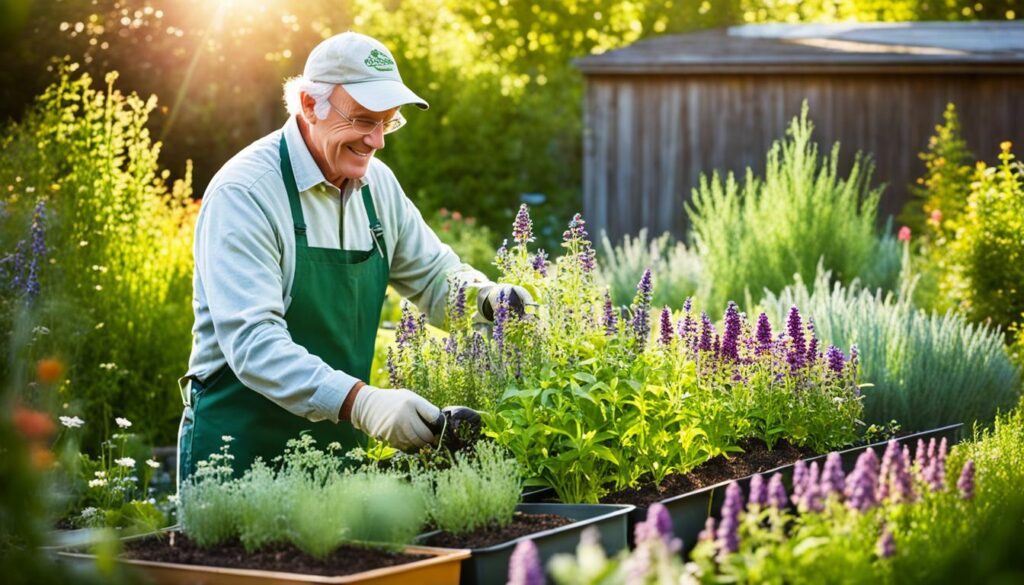
Harvesting and Preserving Your Herbs
Proper herb harvesting and preservation is key to enjoying your herbs all year. Drying and storing herbs well is a great way to keep their flavor and benefits for months.
Drying and Storing Herbs for Year-Round Use
Drying herbs is a simple way to keep their flavor and benefits. When done right, drying herbs keeps their taste, smell, and health benefits for months. This lets you enjoy your garden’s harvest all year.
To dry and store herbs well, follow these steps:
- Harvest herbs just before the flowers bloom, when the oils are strongest.
- Wash and pat the herbs dry, leaving them almost dry.
- Hang them in a cool, dry spot, or use a dehydrator at the right temperature.
- Once dry, put them in airtight containers, like glass jars or bags, away from light and heat.
By drying and storing herbs right, you can use them all year in many recipes and remedies.
“Drying herbs is a simple yet efficient way to preserve their potent medicinal and culinary properties.”
| Herb | Drying Time | Storage Conditions |
|---|---|---|
| Lavender | 7-10 days | Cool, dark place |
| Rosemary | 5-7 days | Airtight container |
| Thyme | 3-5 days | Sealed jar or bag |
Creating Herbal Remedies at Home
Learn to make your own herbal remedies at home with your medicinal herb garden. You can turn your herbs into herbal teas, tinctures, and salves. These natural healing products can be made at home. This lets you create remedies that fit your family’s health needs.
Tinctures, Salves, and Teas for Natural Healing
Tinctures are strong extracts made from herbs soaked in alcohol or vinegar. They help with many health issues, like boosting immunity or reducing inflammation. Salves are creams made with herbs, oils, and beeswax. They’re great for skin and muscle care.
Herbal teas are a tasty way to use medicinal herbs every day. They can help with digestion or help you relax. The right herbs can offer natural healing.
- Craft your own unique herbal remedies using the herbs you’ve grown
- Discover the versatility of tinctures, salves, and herbal teas for natural healing
- Tailor your herbal preparations to address your family’s specific health needs
“The true medicine of the future will be the utilization of the healing powers of nature.” – Henry Lindlahr
Enjoy making your own herbal remedies and use your medicinal herb garden’s healing power. With practice and creativity, you can support your family’s wellness with the plants you’ve cared for.
Incorporating Herbs into Your Diet
Using medicinal herbs isn’t just for health issues. You can also add them to your daily meals for their nutritional benefits. Herbs like rosemary, thyme, and basil make food taste great and are packed with antioxidants and anti-inflammatory compounds. Adding herbs from your garden to your cooking is a tasty way to boost your health.
Herbs fit into many dishes, from soups to salads and main courses. Adding herb-infused recipes to your meals can bring both culinary and medicinal benefits. This makes your meals more enjoyable and healthy.
- Sprinkle fresh basil or oregano on your homemade pizza for a burst of flavor and antioxidants.
- Incorporate rosemary or thyme into roasted vegetables for an anti-inflammatory boost.
- Add a handful of chopped parsley or cilantro to your favorite pasta dish for a nutrient-rich garnish.
| Herb | Culinary Use | Medicinal Benefits |
|---|---|---|
| Rosemary | Roasted meats, potatoes, and vegetables | Antioxidant, anti-inflammatory, may improve cognitive function |
| Peppermint | Teas, smoothies, and desserts | Soothes digestive issues, may relieve headaches |
| Turmeric | Curries, rice dishes, and marinades | Powerful anti-inflammatory properties, may support joint health |
Trying out different culinary herbs in your cooking is an easy way to boost your diet’s nutritional benefits. Enjoy the taste and health perks these plants offer.

Troubleshooting Common Herb Garden Issues
Keeping a medicinal herb garden healthy means watching over it closely and fixing problems fast. You might face pests or diseases that can harm your herbs. By paying attention to your plants and using green solutions, you can beat these issues and keep your garden thriving.
Identifying and Treating Pests
Pests can pop up in any garden, including your herb garden. Aphids, spider mites, and slugs can damage your herbs. To fight these pests, try organic ways like adding beneficial insects, using neem oil, or making insecticidal soap at home.
Managing Plant Diseases
Your herbs might also get sick with things like powdery mildew or fungal infections. Catching these problems early and treating them quickly is crucial. Use green disease control methods, like cutting off sick leaves, improving air flow, and natural fungicides like copper or sulfur.
By being watchful and using organic solutions for pest control and disease management, your herb garden will stay healthy and full of life. With some care, your medicinal herbs will keep growing well, giving you lots of natural remedies.
“The key to a healthy, productive herb garden is understanding and addressing any challenges that arise, using sustainable and eco-friendly methods.”
Expanding Your Herbal Knowledge
Starting your herbal gardening journey means always learning more. It helps you understand and value the plants you grow. Look for good books, online courses, and expert advice to learn about herb properties and herb uses. Working on your own and teaming up with skilled herbalists can make you better at using your herb garden. This can help you use these natural remedies every day.
Resources for Learning About Herb Properties and Uses
To grow your herbal knowledge, check out these herbal resources:
- Comprehensive herbal reference books that delve into the history, science, and applications of various medicinal plants
- Online courses and webinars led by reputable herbalists and experts in the field
- Local herb workshops and community classes that provide hands-on learning experiences
- Joining herbal enthusiast groups, either in-person or online, to network and exchange knowledge with fellow herb gardeners
- Subscribing to herbal publications and blogs that offer the latest insights and research on herb properties and herb uses
By always learning more through self-study and using these herbal resources, you can really appreciate the complex world of medicinal herbs. This can help you get the most out of your herb garden.
Conclusion
Herbal gardening is a rewarding way to grow your own medicinal and culinary herbs. It’s a natural way to improve your health and your family’s well-being. By planning and designing your garden well, you can make a space that helps your body and spirit.
As you learn more about herbs, you’ll find joy in using them in your daily life. These plants can boost your health, soothe stomach issues, and make your food taste better. They can change how you feel and help you take control of your health.
Starting your herbal gardening journey is exciting, whether you’re new or experienced. You’ll feel more alive, independent, and connected to nature. Growing your own medicinal herbs and culinary herbs brings many benefits. It’s a chance to embrace natural wellness and self-sufficiency.
FAQ
What are the benefits of growing a medicinal herb garden?
Growing a medicinal herb garden lets you use herbs for health. It’s a natural way to improve your family’s wellness. You can make your own herbal remedies.
How do I choose the right herbs for my garden based on my climate and growing conditions?
Pick herbs that do well in your area’s climate and soil. Think about how much sun your garden gets and how much space you have. Choose a mix of herbs that grow well together.
What are some key design considerations for planning an optimal medicinal herb garden layout?
Plan your garden carefully to make the most of your space. Think about how much sun each plant needs and the soil quality. Use companion planting to keep pests away and attract bees.
What are the medicinal benefits of growing herbs like echinacea and lavender?
Echinacea boosts the immune system and fights infections. Lavender calms the skin and reduces inflammation. These herbs can help your family stay healthy naturally.
How can I use culinary herbs like peppermint for their medicinal properties?
Culinary herbs like peppermint are also good for health. Peppermint eases digestive issues and helps with headaches. Use these herbs in your cooking and remedies for better health.
What are some sustainable gardening practices I can implement to maintain a thriving medicinal herb garden?
Use sustainable gardening like companion planting to keep pests away and attract bees. This approach keeps your garden healthy without harmful chemicals. It makes your garden good for the environment and your plants.
How do I properly harvest and preserve my medicinal herbs for year-round use?
Harvest and dry your herbs to keep them fresh all year. Drying is a great way to store herbs for teas and remedies. Keep your herbs dry and stored right to keep their healing powers.
What are some common challenges I may face in maintaining a medicinal herb garden, and how can I address them?
Your herb garden might face pests or diseases. Use organic methods to solve these problems. Know what’s wrong with your plants and use safe remedies to fix them. This way, you can keep your garden healthy and enjoy its benefits.
Source Links
- https://melissaknorris.com/how-to-plan-a-medicinal-herb-garden/ – Medicinal Herb Garden (Planning and Growing)
- https://homesteadingfamily.com/medicinal-herbs-their-uses/ – Medicinal Herbs & Their Uses
- https://www.libertymissionfarms.com/post/medicinal-and-culinary-herb-garden – Medicinal and Culinary Herb Garden
Plant Propagation Techniques: Expand Your Garden Easily
Do you love gardening and want to grow more plants without spending a lot? Learn about plant propagation to multiply your favorite plants easily. This way, you can make your garden lush and full without spending a lot of money.
Key Takeaways
- Understand the fundamentals of sexual and asexual plant propagation techniques
- Learn how to propagate plants from seeds, cuttings, division, and more
- Discover the benefits of plant propagation for sustainable and cost-effective gardening
- Explore the versatility of propagation methods to expand your garden’s diversity
- Acquire practical tips and tricks to ensure successful plant multiplication
Gardening lovers often ask, “How can I grow my garden without spending a lot?” The answer is in plant propagation. By learning these methods, you can make your garden thrive. It will show off your style and love for nature.
What is Plant Propagation?
Plant propagation is the act of making new plants. You can do this through seeds or by using parts of the plant itself, like cuttings or divisions. This method helps gardeners grow their plant collections, save money, and keep rare plants alive.
Asexual vs. Sexual Propagation
Sexual propagation uses the plant’s flowers and creates new, unique plants. Asexual propagation makes copies of the original plant using its other parts. Both ways have benefits – sexual can bring new traits, and asexual is quicker and simpler.
Benefits of Plant Propagation
- Expand your garden with plant reproduction techniques
- Save money by cloning your favorite plants
- Quickly fill empty spaces with vegetative growth
- Preserve rare or heirloom varieties for plant preservation
- Share plants with friends and family to grow your garden
- Back up valuable specimens in case of loss or damage
Learning how to propagate plants lets gardeners multiply their plants for free. It helps them expand their gardens and save money. With some time and effort, the possibilities for plant propagation are endless.
“Propagation allows you to share the plants you love and create a thriving, diverse garden.”
Sexual Propagation from Seeds
Starting plants from seeds is a great way to grow your garden. It’s good for both hybrid seeds and open-pollinated types. Knowing how to pick, store, and germinate seeds is important for success.
Seed Selection and Storage
Choosing top-quality seeds is the first step to growing healthy plants. Hybrid seeds are pricier but offer benefits like better seed viability and resistance to diseases. Keep your seeds in a cool, dry spot to keep them good for 1 to 6 years, depending on the type.
Germination Requirements
- Water: Seeds need steady moisture to start growing.
- Oxygen: The soil must have enough oxygen for seeds to germinate.
- Light: Some seeds germinate with light, others in darkness. Know what your seeds need.
- Soil temperature: The right temperature, usually 65-75°F, helps seeds germinate best.
Using methods like scarification and stratification can help seeds start growing better.
“The key to successful seed propagation lies in understanding the unique needs of each plant and providing the optimal conditions for seed germination.”
| Seed Type | Typical Lifespan |
|---|---|
| Vegetable Seeds | 1-6 years |
| Flower Seeds | 1-4 years |
| Herb Seeds | 2-4 years |
Asexual Propagation Techniques
Gardeners looking to grow more plants quickly can use asexual propagation. This method creates new plants from parts of an existing one, like stems or leaves. It’s a way to make many genetically identical clones of the original plant.
Some popular ways to do this include:
- Taking stem cuttings
- Dividing rhizomes or tubers
- Air layering
- Grafting
- Propagating from runners or offsets
These methods help gardeners expand their plant collections quickly and affordably. By cloning and multiplying their favorite plants, they can grow a diverse garden with ease. With some skill and patience, anyone can use asexual propagation to create a beautiful garden.
“Asexual propagation is a game-changer for gardeners who want to grow their plant collections without the time and effort required for seed-based methods.”
Propagation by Cuttings
Taking stem cuttings is a popular way to grow new plants from ones you already have. It’s a simple method to expand your garden. You’ll need some supplies and a clear process to follow.
Supplies Needed
- Healthy parent plant
- Sharp, clean cutting tool
- Container for rooting
- Potting soil or soilless medium
Step-by-Step Process
- Select 4-8 inch stem cuttings from the parent plant, making a diagonal cut just below a leaf node.
- Place the cuttings in water and allow the roots to develop over about a week.
- Once the roots reach 4 inches long, transplant the new plants into pots filled with a well-draining potting mix.
Keep the soil moist but not too wet during the rooting phase. Slowly get the young plants used to less humidity and more light over weeks. Then, move them to their final spot.
“Propagating plants from cuttings is a rewarding way to expand your garden with minimal effort.”
Using the right rooting hormone and careful acclimation helps you grow many plants from stem cuttings. This method is affordable and efficient, perfect for growing your plant collection.
Propagation by Division
Expanding your garden is rewarding, and division is an easy way to do it. This method is great for plants with rhizomes, tubers, or dense clumps. By digging up and dividing the roots, you can make many new plants from one.
Plants Suitable for Division
Many perennials, herbs, and ornamental grasses are perfect for division. Some examples include:
- Daylilies
- Irises
- Hostas
- Ornamental salvias
Dividing crowded plant clumps helps your garden grow and rejuvenates the parent plants. It’s especially good for plants with rhizomes or tubers. It encourages new, strong growth.
| Plant Type | Recommended Division Frequency |
|---|---|
| Daylilies | Every 3-4 years |
| Irises | Every 2-3 years |
| Hostas | Every 3-5 years |
| Ornamental Salvias | Every 2-3 years |
Follow these guidelines and divide your plants regularly. This way, you’ll have a healthy, thriving garden for years.
Propagation by Layering
If you want to grow your garden with little work, try layering. This method involves bending a stem and burying it in soil. It helps create adventitious roots and a new plant. It’s great for plants that spread by runners or have low-growing stems.
There are different ways to layer, like tip layering, simple layering, compound layering, and mound layering. The main thing is to keep the soil moist for the roots to grow. Once the new plant is strong, you can move it to another spot. This way, you can spread your favorite plants easily.
“Layering is a fantastic way to multiply your favorite plants with minimal effort. It’s a game-changer for gardeners looking to expand their collection without breaking the bank.”
For layering to work well, watch the plant spreaders and the environment. With the right conditions and patience, you can grow new plants easily. Your garden will soon be full of life.
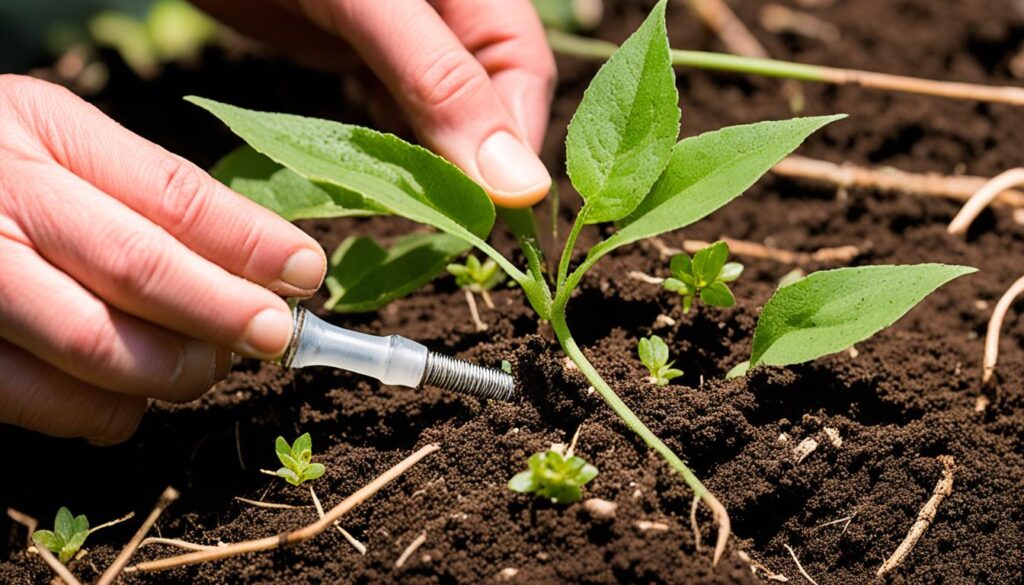
plant propagation
If you want to grow your garden without much work, try plant layering. This method uses the natural ability of plants to root at their joints. It lets you make new plants from ones you already have. Let’s look at the different ways you can layer plants to make your garden bigger and more vibrant.
Tip Layering: Bending the Rules
Tip layering is a great way to grow new plants. You just bury the tip of a stem and let it grow downward before it bends back up. It’s perfect for plants that trail or climb, making it easy to get more plants.
Mound Layering: Raising the Bar
Mound layering, or stool layering, means adding soil around a plant’s base to encourage new shoots. It’s great for shrubs and trees. This method helps you grow and spread your favorite woody plants easily.
Air Layering: An Indoor Solution
Air layering, or pot layering, is ideal for indoor gardeners. You wrap a stem section in sphagnum moss to help it root. Once it has roots, you can cut it off and plant it, easily growing more plants indoors.
Whether you choose tip layering, mound layering, or air layering, these methods are great for growing your favorite plants. They make it easy to add more life to your garden. Try layering and see your garden thrive.
Propagation by Grafting and Budding
Boost your gardening skills with grafting and budding. These are special ways to grow plants without using seeds. They join the rootstock and scion (or bud) of different plants. This creates a new plant with special traits.
Grafting and budding have many benefits. They help plants grow better and resist diseases. By picking the right rootstock and scion, you can make plants that do well in your garden.
Grafting Techniques
Grafting takes skill but is very rewarding. There are a few ways to graft plants, including:
- Splice Grafting: This method matches the growing layers of the rootstock and scion for a strong bond.
- Whip Grafting: This method connects the cut ends of the rootstock and scion securely.
- Approach Grafting: This method connects the rootstock and scion while they are still on their plants, making a natural join.
Budding: The Art of Bud Insertion
Budding is a delicate way to grow plants. It involves putting a bud from one plant into another. This is great for plants that are hard to grow from seeds or cuttings.
| Grafting | Budding |
|---|---|
| Joining the rootstock and scion | Inserting a bud from one plant into the stem of another |
| Requires skilled hand-eye coordination | Demands a steady hand and precise technique |
| Allows for customization of plant traits | Enables the propagation of difficult-to-grow plants |
Whether you pick grafting or budding, these methods can change your garden. They let you bring out the best in your plants. Start your journey to gardening success today.
Propagation from Bulbs, Tubers, and Rhizomes
Many plants and some veggies grow from underground parts like bulbs, tubers, and rhizomes. These can be split to make new plants. As the main plant grows, it makes small new bulbs called bulbils or offsets that you can take and plant. For example, daffodils, dahlias, and irises do this. Splitting these plants is a great way to grow more of these popular flowers quickly.
Identifying Bulbils and Offsets
Bulbils are tiny bulbs that grow on the main plant, often near the base or in the leaf joints. Offsets are young plants that grow from the main plant’s base, connected by a small stem or rhizome. You can take these off and plant them to make more bulbs, tubers, and rhizomes.
| Plant Type | Propagation Method | Examples |
|---|---|---|
| Bulbs | Plant division | Daffodils, tulips, lilies |
| Tubers | Plant division | Dahlias, potatoes |
| Rhizomes | Plant division | Irises, ginger, cannas |
Knowing how to spot and grow from these underground parts lets gardeners easily increase their bulbs, tubers, and rhizomes. This way, they can have a beautiful garden full of their favorite plants.
“Dividing these types of plants is a simple but effective asexual propagation method that allows gardeners to rapidly expand their collections of these popular flowering plants.”

Propagation from Runners and Stolons
Gardeners can easily grow more plants by using a natural method – runners and stolons. These stems help plants like strawberries, ivy, and spider plants spread and create new plants.
To multiply your garden, just cut off the new plantlets from the runners and stolons. This is a simple way to grow more plants without seeds or complicated methods.
To propagate plants with runners and stolons, follow these steps:
- Identify the plant’s runners or stolons – these will be the horizontal stems growing along the surface of the soil.
- Look for new plantlets forming at the nodes along the runners/stolons.
- Carefully cut the new plantlet away from the parent plant, ensuring it has its own root system.
- Transplant the new plantlet to a prepared planting spot, keeping the soil moist until it becomes established.
With patience and care, you can use the natural spreading of plants like strawberries, spider plants, and others to grow your garden. This method is perfect for beginners or experienced gardeners to fill in their gardens.
| Plant | Propagation Method | Rooting Time |
|---|---|---|
| Strawberries | Runners | 2-4 weeks |
| Ivy | Stolons | 3-6 weeks |
| Spider Plants | Runners | 1-2 weeks |
Tissue Culture Propagation
In the world of plant propagation, a new method is changing the game – tissue culture. This method grows tiny plant tissues in a sterile environment with special nutrients. It lets us make many copies of rare or valuable plants quickly and efficiently.
This method works best in a clean lab setting. Growers keep everything clean to avoid contamination. This ensures the plants grow strong and healthy.
Tissue culture needs special tools and knowledge. But it’s worth it because it helps grow hard-to-find plants like orchids. This makes these plants more available to gardeners and plant lovers.
“Tissue culture propagation is a game-changer in the world of plant cultivation, unlocking new possibilities for rare and valuable species.”
If you’re into growing plants or just starting, learning about tissue culture is key. It lets you grow more diverse plants and explore new gardening possibilities. Plus, you keep your plants healthy and of high quality.
Conclusion
Learning how to grow plants from cuttings and seeds lets you expand your garden without spending a lot. You can use methods like seed starting, stem cuttings, division, and layering to grow more of your favorite plants. This way, you can fill empty spots in your garden and keep rare plants alive.
With some patience and the right tools, anyone can become great at growing plants. By using garden expansion, cost savings, and plant preservation through propagation, you can make your garden thrive. Try these methods and see your garden grow.
There are so many ways to grow and refresh your garden with plant propagation. Start growing more of your plants, one cutting or seed at a time, and enjoy the process.
FAQ
What is plant propagation?
Plant propagation is making new plants. You can do this through seeds or by using parts of the plant itself, like cuttings or divisions.
What are the main types of plant propagation?
There are two main ways to propagate plants. Sexual propagation uses flowers and makes new plants that are different from the parent. Asexual propagation makes copies of the parent plant using its other parts.
What are the benefits of plant propagation?
Propagating plants helps you grow your garden, save money, and keep rare plants alive. It lets you make more plants for free, fill your garden fast, and share plants with others.
How do you propagate plants from seeds?
To start plants from seeds, pick good seeds and store them right. Make sure they have water, air, light, and heat to grow.
What are some common asexual propagation techniques?
Common ways to propagate plants include taking cuttings, dividing roots, air layering, grafting, and using runners or offsets.
How do you propagate plants from cuttings?
For cuttings, use a healthy plant, a sharp tool, a rooting container, and soil. Cut 4-8 inch stems, put them in water, and wait for roots. Then, move them to pots.
What types of plants can be propagated by division?
Plants with underground stems or clumps, like many perennials and herbs, can be divided to make more plants.
What is layering in plant propagation?
Layering makes new plants by bending a stem and burying it. This helps roots grow and a new plant starts. There are different ways to layer, like tip and mound layering.
How does grafting and budding work for plant propagation?
Grafting and budding join a piece of one plant to another, making a new plant that’s the same as the first one. These methods can help plants grow better and fight diseases.
Can plants be propagated from bulbs, tubers, and rhizomes?
Yes, plants that grow from bulbs, tubers, and rhizomes can be divided to make more plants. These underground parts produce new plants that can be taken and planted separately.
How do runners and stolons facilitate plant propagation?
Some plants spread by making horizontal stems called runners. Gardeners can cut these runners to make new plants. This is a way to grow more plants naturally.
What is tissue culture propagation?
Tissue culture is a modern way to make new plants. It takes small plant pieces and grows them in a clean lab with special food. This makes lots of identical plants quickly.
Source Links
- https://extension.umaine.edu/gardening/manual/propagation/plant-propagation/ – Plant Propagation – Cooperative Extension: Garden and Yard – University of Maine Cooperative Extension
- https://www.skh.com/thedirt/plant-propagation-techniques/ – Plant Propagation Techniques: Learn How To Propagate Plants
- https://stonepostgardens.com/12-plant-propagation/ – 12 Easy Methods for Plant Propagation to Multiply Your Garden
Greenhouse Gardening: Extend Your Growing Season
Are you ready to unlock the secrets of year-round gardening? Greenhouse gardening could be the game-changer you’ve been searching for. By creating a controlled environment, greenhouses can extend your growing season by up to 60%. This lets you enjoy fresh produce long after your outdoor garden has gone dormant. But is this sustainable approach to gardening truly worth the investment?
Key Takeaways
- Greenhouse gardening can extend your growing season by up to 60%
- Greenhouses provide a controlled environment to protect your plants from harsh weather and pests
- Unheated and heated greenhouses both offer unique benefits for year-round gardening
- Hoop houses and row covers can further extend your growing season at home
- Greenhouse gardening allows you to grow a wider variety of plants, including herbs and annuals
Introduction to Greenhouse Gardening
Greenhouse gardening opens up new possibilities for extending your growing season and boosting your crop yields. It lets you create the perfect conditions for your plants to grow, no matter the weather outside. Whether you pick an unheated or heated greenhouse, the benefits are many and can change your gardening for the better.
Benefits of Using a Greenhouse
Growing in a greenhouse brings many benefits that can change your gardening. A greenhouse advantages include controlling temperature, humidity, and light for your plants. This controlled environment keeps your crops safe from pests, bad weather, and losing nutrients, leading to healthier, more productive plants.
Extending the Growing Season by Up to 60%
One big plus of greenhouse gardening is the chance to extend your growing season by up to 60%. By controlling the greenhouse temperature control, you can start seeds early in spring and keep harvesting into fall and winter. This lets you have a steady supply of fresh produce for longer, making your garden a year-round food source.
For both new and experienced gardeners, the perks of greenhouse gardening are exciting and motivating. Using a controlled environment helps you achieve new levels of gardening success. You get to enjoy the fruits of your labor for months, thanks to the power of a greenhouse.
Unheated vs Heated Greenhouses
Choosing between an unheated greenhouse and a heated greenhouse is key to your gardening success. It depends on your climate and what you want to grow. Knowing the good and bad of each type will help you pick the right one for your garden.
An unheated greenhouse uses the sun’s warmth to stay cozy. It’s a budget-friendly choice that works well in mild climates. You can grow many plants for a longer season. But, it might not let you grow plants all year like a heated greenhouse can.
Heated greenhouses let you grow plants all year, no matter the weather outside. This means you have more control over your plants. But, you’ll spend more on energy to keep it warm.
| Feature | Unheated Greenhouse | Heated Greenhouse |
|---|---|---|
| Climate Considerations | Suitable for milder climates | Suitable for a wider range of climates |
| Growing Season | Extended growing season | Year-round growing capabilities |
| Operating Costs | Lower energy costs | Higher energy costs for heating |
When deciding between unheated and heated greenhouses, think about your climate, what you want to grow, and your budget. Look at the climate considerations, cost comparison, and how much you want to extend your growing season. This will help you choose the best option for your gardening dreams.
At-Home Hoop Houses for Extended Growing
Gardeners looking for an affordable greenhouse can try at-home hoop houses. These are simple structures with frames and plastic coverings. They let you grow plants longer, starting early in spring and ending late in fall.
Hoop houses protect plants from rain, wind, and cold. They create a warm spot inside, making the growing season longer by up to 5 months. This means you can grow more fruits, vegetables, and herbs.
Growing Season Duration for Hoop Houses
Hoop houses are great for gardeners who want to grow more without spending a lot. They are a smart choice for season extension and cold weather protection. This makes them a cost-effective greenhouse option.
“Hoop houses are a great way for gardeners to extend their growing season without breaking the bank.”
For both new and experienced gardeners, adding a hoop house can change the game. With proper planning and care, these simple structures can give you a long harvest season.
Late Fall and Early Winter Harvests
Greenhouse gardening lets you keep harvesting into late fall and early winter. By moving cold-hardy veggies like carrots, spinach, and kale inside, you can get fresh produce long after the outdoor season ends.
The greenhouse’s warm and humid environment helps these tough crops grow even when it’s cold outside. This means you can keep enjoying late season harvests and taste the goodness of cold-hardy crops all winter.
Moving Plants Inside the Greenhouse
You can also bring potted plants and delicate herbs inside the greenhouse to keep them growing. The greenhouse microclimate is perfect for these plants, letting you have lovely flowers and fresh herbs all winter.
By relocating indoor plants to the greenhouse, they stay safe from harsh weather. This way, they keep thriving and give you lots of harvest even when it’s cold.
“Extending the growing season through greenhouse gardening is a game-changer, allowing me to enjoy a steady supply of fresh produce long after my outdoor garden has gone dormant.”
Year-Round Growing with Greenhouses
Gardeners looking to grow plants all year can use greenhouses and protection tents. These structures protect plants from bad weather and pests. They let tender plants grow even when it’s cold. Protection tents are a budget-friendly way to garden all year, perfect for many gardeners.
Protection Tents for Year-Round Gardening
Protection tents are smaller and easy to move, great for any backyard or patio. They offer the same benefits as big greenhouses, keeping plants warm and safe. These tents are perfect for growing tender crops or extending the season for herbs. They make year-round gardening easy and affordable.
- Protect plants from harsh weather conditions, such as frost, wind, and heavy rain
- Extend the growing season by up to 60% for many crops
- Affordable and space-efficient solution for small-scale gardeners
- Allows for the cultivation of year-round vegetables, herbs, and flowers
Using protection tents lets gardeners get more from their gardens and enjoy greenhouse season extension all year. With some effort and care, you can make a beautiful, year-round garden in your backyard.
Monitoring Greenhouse Temperature
Keeping the right temperature in your greenhouse is key for your plants’ health and growth. If the temperature changes too much, your plants might grow slow, get sick, or even die. So, it’s important to watch the temperature closely and adjust it as needed to help your plants do well.
Importance of Temperature Monitoring
Thanks to modern tech, like remote monitoring and digital sensors, it’s easy to keep an eye on your greenhouse’s temperature and humidity. By watching these levels closely and making changes when needed, gardeners can make sure their plants get the best conditions. This helps plants stay healthy all season long.
- Maintain optimal greenhouse temperature control for healthy plant growth
- Detect and address temperature fluctuations quickly with temperature monitoring solutions
- Utilize remote monitoring technologies to track conditions from anywhere
- Adapt growing practices to provide the perfect environment for your plants
By keeping an eye on your greenhouse’s temperature and adjusting it when needed, you can grow plants longer and get more from your garden. With the right tools for monitoring, you can make your greenhouse the perfect place for your plants to flourish.
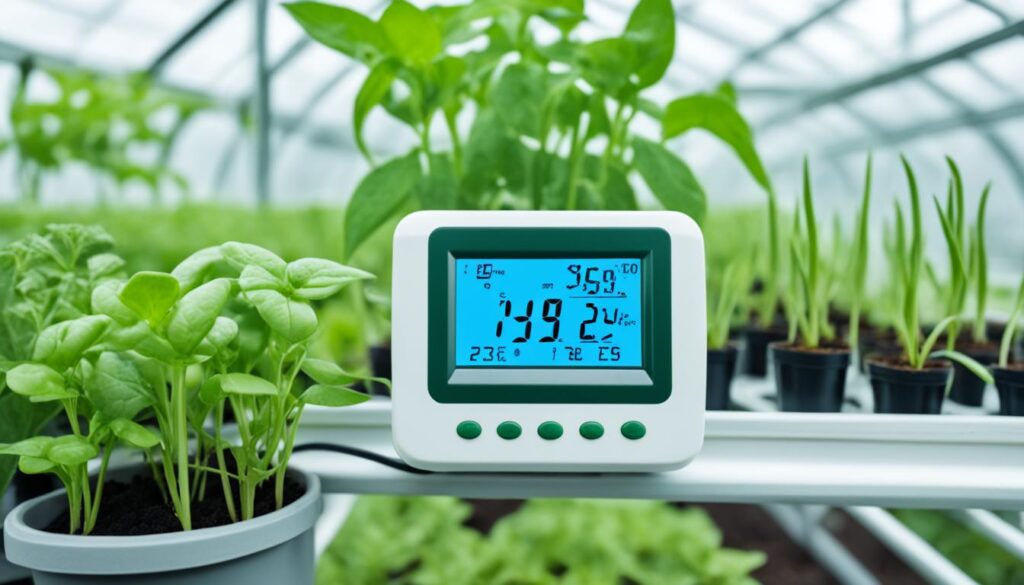
“Consistent temperature monitoring is the key to unlocking the full potential of your greenhouse gardening.” – Gardening Guru, Jane Doe
Floating Row Covers for Plant Protection
Row covers are a big deal for greenhouse gardening. They’re lightweight and let air and light through. This gives your plants an extra shield against cold snaps and pests. Adding row covers to your greenhouse setup helps your plants grow longer and stay safe.
Row covers are great for protecting against frost. In spring and fall, they keep seedlings and crops warm. Even in cold winters, the right row covers keep plants healthy and growing.
Row covers do more than just fight frost. They also keep insects, birds, and pests away from your plants. This means less damage and disease, leading to a bigger harvest.
If you want to improve your greenhouse gardening, think about using row covers. They offer many benefits, like protecting against frost and pests. These tools can make your plants last longer and grow better all season.
“Floating row covers are a must-have for any greenhouse gardener who wants to push the boundaries of their growing season.”
Transitioning to Outdoor Summer Growing
As the growing season moves forward, gardeners should think about moving some plants from the greenhouse to the outdoors. This shift makes the greenhouse more efficient. It also opens up space for more summer harvest crops.
When moving plants outside, it’s important to acclimate them gradually. This means starting with a little outdoor time and slowly adding more. This helps the plants get used to the sun and changing temperatures without shock.
Moving plants outside in the summer can boost their growth and yields. This means a bigger summer harvest for you. Using both the greenhouse and outdoor space can make your garden more efficient.
“Transitioning plants outside is like introducing a friend to a new environment – it takes time, patience, and care to ensure a smooth adjustment.”
The aim is to balance the greenhouse and the garden. This way, you make the most of your space all summer.
| Benefits of Transitioning Plants Outdoors | Considerations for Outdoor Acclimation |
|---|---|
|
|
Extending the Life of Annual Herbs
Greenhouses are great for making annual herbs like basil and cilantro last longer. These herbs are hard to grow all year in cold places. With a greenhouse environment that controls temperature, gardeners can have fresh herbs all year.
In a greenhouse, these delicate annual herbs do well. Gardeners can pick their favorite herbs from fall to winter. This way, they can enjoy fresh, tasty herbs all season long.
Using Greenhouses for Herb Growth
Greenhouses are perfect for growing herbs all year. They let gardeners keep their favorite herbs going even when it’s not the right time outside. Inside, plants are safe from bad weather. They get the right amount of light, temperature, and humidity to grow well.
| Herb | Outdoor Growing Season | Greenhouse Growing Season |
|---|---|---|
| Basil | Summer | Year-round |
| Cilantro | Spring to Fall | Year-round |
| Parsley | Spring to Fall | Year-round |
Using a greenhouse lets gardeners keep their annual herbs going all year. They can have a lot of herbs, no matter the weather outside.
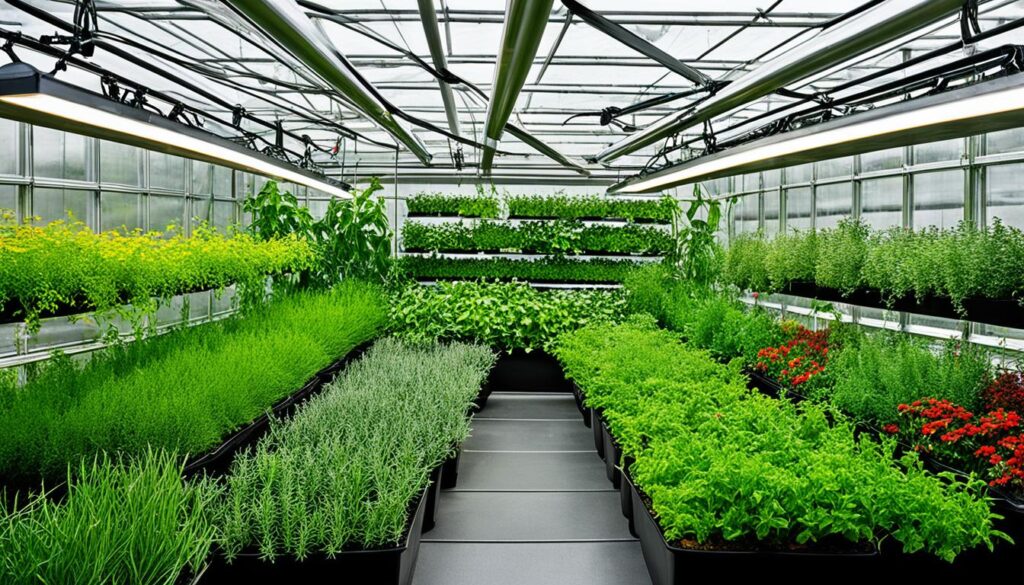
Greenhouse Gardening: Crop Choices
When planning your greenhouse garden, think about the crops that do well in the controlled space. Choose cold-hardy veggies like carrots, beets, and bunching onions for early planting. They handle cooler greenhouse temperatures well.
Later in the season, grow a variety of crops such as tomatoes, peppers, and cucumbers. For the best results, prepare the beds well. Till the soil 8-12 inches deep, add soil amendments, and cover rows with row covers to fight weeds before planting.
Preparing Greenhouse Beds for Planting
Choosing the right crops and preparing the space well can boost your greenhouse garden’s success. Here are steps to prepare your beds:
- Till the soil 8-12 inches deep for better root growth and air flow.
- Add organic stuff like compost or manure to make the soil richer and more fertile.
- Use row covers or mulch to keep weeds down and soil moist.
- Check the soil’s pH and adjust it if needed for your crops.
| Crop | Ideal Temperature Range | Ideal Soil pH |
|---|---|---|
| Tomatoes | 70-85°F | 6.0-6.8 |
| Peppers | 65-85°F | 6.0-6.8 |
| Leafy Greens | 55-75°F | 6.0-7.0 |
Plan your greenhouse crops and prepare your beds well. This way, you can have a thriving garden that grows more food for longer.
“Greenhouse gardening lets me grow more crops and extend my growing season. The key is to pick the right crops and prepare the beds right.”
Greenhouse Gardening Techniques
Greenhouse gardening needs special techniques for the best plant growth. Start with preparing your beds well. This means tilling the soil, adding nutrients, and using row covers to keep weeds away. It’s also key to think about ventilation, temperature, and moving plants between the greenhouse and outside.
To make the most of your greenhouse, use special planting methods. Start seeds indoors, move seedlings to the greenhouse, and manage temperature and humidity. Preparing your beds and optimizing conditions lets you grow more, longer, and enjoy fresh produce all year.
Preparing Greenhouse Beds for Planting
Before planting, make sure your beds are ready. Till the soil, add compost or manure, and use row covers for weeds. This makes a healthy, weed-free place for your plants to grow.
- Till the soil to a depth of 6-8 inches, breaking up any compacted areas.
- Mix in 2-4 inches of compost or other organic amendments to improve soil structure and fertility.
- Use floating row covers to block light and prevent weed growth between plantings.
Optimizing Greenhouse Conditions
Managing temperature, humidity, and ventilation is also crucial. This might mean using climate control systems, checking conditions, and adjusting as needed.
- Install a reliable thermometer and hygrometer to track temperature and humidity levels.
- Ensure adequate ventilation to prevent stagnant air and maintain proper air circulation.
- Utilize supplemental heating or cooling systems to maintain the ideal temperature range for your crops.
Using these greenhouse gardening tips, you can make the most of a protected space. This leads to a longer season, more produce, and fresh, quality food. With some knowledge and care, your greenhouse can be a thriving place for your plants.
“Greenhouse gardening allows me to grow a wider variety of crops and extend my growing season by several months. The extra control over environmental factors has been a game-changer for my home garden.”
– Sarah, Experienced Greenhouse Gardener
Conclusion
Greenhouse gardening opens up new chances for gardeners to grow more and longer. It lets you control the environment, making it perfect for many plants. You can grow everything from hardy veggies to delicate herbs and flowers.
Choosing between an unheated or heated greenhouse, or even a cheaper hoop house, changes everything. You can control the temperature, humidity, and light. This means you can grow food into late fall and early winter.
By watching the greenhouse conditions and using things like row covers, you can make a garden that grows all year. With some effort and the right methods, greenhouse gardening can change the game for all gardeners. It opens up new possibilities in your backyard.
Greenhouse gardening is full of potential. It lets you grow more, try new plants, and have a garden all year. If you’re starting or want to improve your gardening, this article has tips to help. It can make your greenhouse gardening successful and rewarding.
FAQ
What are the benefits of using a greenhouse?
Greenhouses let gardeners extend their growing season by up to 60%. They control temperature, humidity, and light for the best plant growth. This means you can start seeds early and keep harvesting into fall and winter. Plants stay healthy and productive by avoiding pests, harsh weather, and nutrient loss.
What’s the difference between an unheated and a heated greenhouse?
Choosing between an unheated or heated greenhouse depends on your climate and needs. Unheated greenhouses use the sun’s heat and are cheaper. They work well in mild climates, extending the growing season. Heated greenhouses let you grow crops all year but cost more to run.
How can at-home hoop houses extend the growing season?
At-home hoop houses, or high tunnels, are a budget-friendly way to extend the growing season. These structures use frames covered in plastic. They can add up to 5 months to your growing season, letting you start and end your crops earlier.
How can greenhouses help extend the late fall and early winter harvests?
Greenhouses let you harvest into late fall and early winter. By moving hardy vegetables like carrots and kale inside, you can enjoy fresh produce longer. The greenhouse’s warm and humid environment supports these plants, even when it’s cold outside.
How can greenhouses and protection tents enable year-round gardening?
Greenhouses and protection tents let gardeners grow crops all year. They protect plants from bad weather and pests, making it possible to garden in cold months. Protection tents are smaller and cheaper, perfect for gardeners with limited space.
Why is it important to monitor greenhouse temperature?
Keeping the right temperature in a greenhouse is key for healthy plants. Temperature changes can harm plants, causing growth problems or even death. Modern tech helps you monitor your greenhouse’s temperature and humidity easily.
How can floating row covers provide additional plant protection?
Floating row covers add extra protection to your plants. They keep out frost in spring and fall, protecting seedlings and crops. Heavy covers can even shield plants from freezing. They also block pests, keeping your crops safe.
When should plants be transitioned from the greenhouse to the outdoor garden?
Moving plants from the greenhouse to outside is important as the season goes on. It makes the greenhouse more efficient and frees up space. Move plants outside slowly, giving them time to get used to the sun and temperature changes.
How can greenhouses help extend the life of annual herbs?
Greenhouses are great for growing annual herbs like basil and cilantro year-round. They provide a warm, humid space for these delicate plants. This way, you can enjoy fresh herbs into the fall and winter.
What should gardeners consider when planning their greenhouse crops?
Think about which crops do well in a greenhouse when planning your garden. Early season, cold-hardy veggies like carrots grow well in greenhouses. Later, you can grow a variety of crops. Prepare your greenhouse beds well, till the soil, add amendments, and use row covers to help plants grow.
Source Links
- https://mrcrazykicks.com/how-much-can-a-greenhouse-extend-the-growing-season/ – How Much Can a Greenhouse Extend the Growing Season?
- https://sunshinegreenhouse.com/blogs/sunshine-greenhouse-kit-blog/using-a-greenhouse-to-extend-the-growing-season – Using a Greenhouse to extend the growing season
- https://www.new-terra-natural-food.com/growing-plants-in-a-greenhouse.html – Growing plants in a greenhouse to extend your growing season
Gardening with Children: Fun Activities for Little Gardeners
Are you ready to turn your backyard or patio into a magical place for your kids? Gardening with children is a great way to teach them about nature and important life skills. It’s full of fun and learning activities that will make your kids excited to help out.
This guide will show you how to make gardening fun and educational for your kids. You’ll learn about easy projects and outdoor adventures that kids love. It’s a chance to create a special bond with your children and help them grow.
Key Takeaways
- Discover a variety of fun and engaging gardening activities for children of all ages
- Learn how to set up a kid-friendly garden space that encourages exploration and learning
- Explore easy seed-starting projects that spark kids’ curiosity about plant growth
- Uncover creative ways to incorporate gardening into outdoor play and crafting
- Dive into the benefits of gardening for children’s development and wellbeing
Introduction to Gardening with Kids
Gardening with children is a journey full of growth, discovery, and bonding. It doesn’t matter if you’re an expert or a beginner. Sharing the natural world with your kids can deeply impact their growth and happiness.
Benefits of Gardening for Children
When kids help with gardening with toddlers, they gain many benefits. This activity helps them:
- Improve their fine motor skills and hand-eye coordination
- Feel a deeper connection with nature
- Learn about plants and how to be sustainable
- Take pride in their work and feel responsible
- Eat healthier as they grow their own food
Setting Up a Kid-Friendly Garden Space
Creating a kid-friendly garden means making it fun and safe for your little family gardeners. Think about adding:
- Raised beds or planters that are easy for small hands to reach
- Tools and accessories made for kids
- Fun things like painted stones, a butterfly puddle, or a sunflower fort
- Areas for exploring, watching, and learning by doing
By doing this, you help your kids love the outdoors and appreciate nature for life.
Easy Seed Starting Activities
Gardening with kids is a great way to make them curious and teach them about nature. Starting seeds is a fun process that lets kids see how plants grow. Two easy projects for kids are the eggshell countertop garden and toilet paper tube seed starters.
Eggshell Countertop Garden
Turn empty eggshells into mini gardens for herbs, microgreens, or small veggies. This activity teaches kids to reuse and get their hands dirty. They plant their own mini garden in the eggshells.
Just crack the eggshells in half, fill them with soil, and let kids pick their seeds. Put the eggshell garden on a sunny windowsill. Water it gently as the seeds grow.
Toilet Paper Tube Seed Starters
Toilet paper tube seed starters are another easy project. They’re great for starting seeds indoors before moving them outside. Kids cut the tubes into 2-inch pieces, fill them with soil, and add their seeds.
Then, put the tubes in a tray or egg carton to keep them upright. These activities let kids be part of the seed starting process from start to finish.
Both the eggshell garden and toilet paper tube starters are great for kids. They learn about planting and watching growth. These simple activities introduce kids to gardening’s joys.
Growing Vegetables from Scraps
Learn to garden sustainably with your kids by growing veggies from kitchen scraps. Items like celery, carrots, and green onions can be regrown in water or soil. Watching them grow, kids learn about food production and waste reduction.
Regrowing Vegetables from Kitchen Scraps
Turn kitchen waste into a garden with these easy steps. This activity teaches kids about nature and the importance of being eco-friendly.
- Save the bottom inch of vegetables like celery, romaine lettuce, or green onions.
- Place the vegetable base in a shallow dish or container filled with water, ensuring the cut end is submerged.
- Set the container in a sunny spot and watch as new growth emerges from the center.
- Once the new shoots are several inches tall, transplant the regrowth into soil for continued growth.
- Encourage your kids to experiment with different kitchen scraps and observe the regrowth process.
By doing kitchen scrap gardening, kids will appreciate regrowing vegetables and regrowth from food waste. This helps them develop a sustainable gardening mindset.
| Vegetable | Part to Regrow | Time to Regrow |
|---|---|---|
| Celery | Bottom 1-2 inches | 7-10 days |
| Green Onions | White base with roots | 5-7 days |
| Romaine Lettuce | Bottom 1-2 inches | 10-14 days |
| Carrot Tops | Top 1-2 inches | 14-21 days |
Enjoy the fun of regrowing vegetables with your little gardeners. Watch their excitement as they see regrowth from food waste. This sustainable gardening teaches kids about waste reduction and food production cycles.
“Gardening is a great way to teach children about the natural world, and regrowing vegetables from scraps is a fantastic hands-on activity that shows them the amazing cycle of life.”
gardening with children: Fun Outdoor Activities
Step outside and explore the fun of family gardening projects! Activities like planting a tree and building a sunflower fort are great ways to connect kids with nature.
Planting a Tree with Kids
Planting a tree teaches kids about caring for the environment and watching growth. Let them help pick the tree, dig the hole, and place the sapling. As the tree grows, they can watch and feel proud of their part in nature.
Building a Sunflower Fort
Building a sunflower fort is a fun family gardening project. Start by planting sunflowers in a circle. Then, help them grow into a cozy fort. Kids can decorate it with ribbons and wind chimes.
These outdoor gardening activities will spark your kids’ curiosity and deepen their love for nature. Enjoy gardening with kids and see their imaginations grow with the plants.
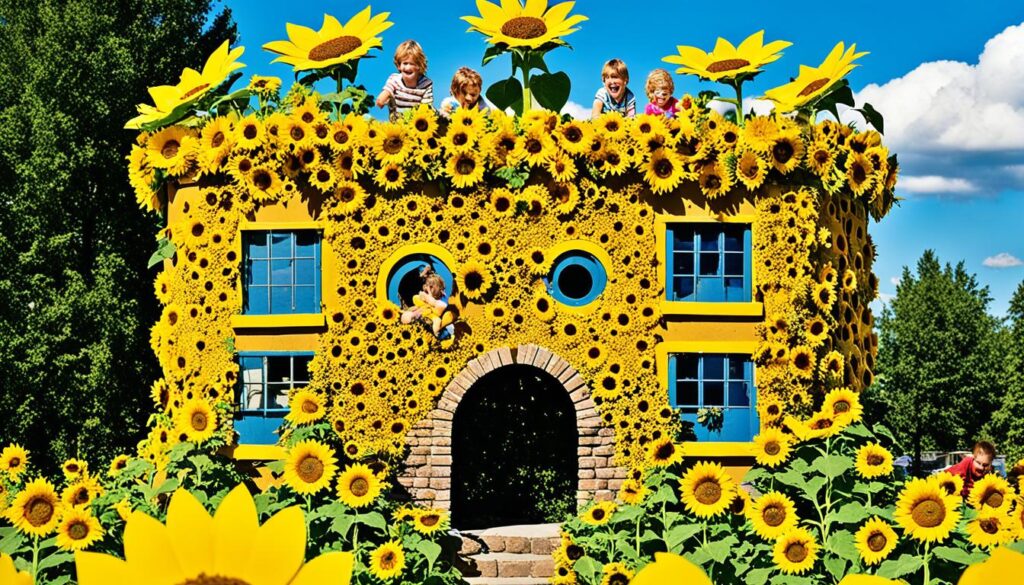
Creative Gardening Crafts
Gardening with kids is more than just planting seeds. It’s about letting them be creative and artistic. Garden stone painting is a fun way to do this. It lets kids show off their style and make their own garden decor.
Start by collecting smooth rocks from your garden or a nearby park. Then, spend time with your kids finding the perfect stones. Once you have your stones, let them get creative. Gardening crafts like this help kids see the beauty in nature and add their own touch.
Kids can paint anything from fun patterns to nature scenes. Encourage them to try out different colors and ways of painting. They might use the stones as plant labels or scatter them in your DIY garden decor. This activity is a great way to bond and appreciate nature’s beauty.
So, bring your family together, get some paint, and start garden stone painting! This family-friendly art project will inspire creativity and make your garden more magical.
Edible Gardening Projects
Gardening with kids is a fun way to show them the beauty of nature. It’s not just about growing flowers. It’s also a chance for them to grow their own healthy snacks. Activities like growing potatoes in a ball jar and sprouting seeds for nutrient-rich snacks make learning exciting.
Growing Potatoes in a Ball Jar
Potatoes are simple to grow and fun for kids. By planting potatoes in a clear jar, they can see the whole growth process. They’ll watch from sprout to tuber, feeling proud of their work.
Sprouting Seeds for Nutrient-Rich Snacks
Seed sprouting is a great way for kids to see how fast nutritious snacks grow. Watching alfalfa, mung beans, or radish seeds turn into microgreens is amazing. They can add their sprouts to smoothies, salads, or eat them as a snack.
These gardening projects teach kids about their food’s origins. They learn to appreciate their work and care for the environment. These activities can make them love gardening and understand the value of edible gardening.
Attracting Nature to Your Garden
Are you ready to turn your outdoor space into a lively, nature-friendly spot? By adding features that draw in helpful insects and wildlife, you can make your kids more curious about nature. One great idea is to make a butterfly puddle. It’s a spot with water and minerals that butterflies need.
Making a Butterfly Puddle
To make a butterfly puddle, pick a shallow dish or container and fill it with sand, gravel, and water. Make sure the water is just below the surface so butterflies can safely get to it. Add some stones or rocks for them to land on.
Pair your butterfly puddle with pollinator-friendly plants to attract bees, hummingbirds, and butterflies. Choose native, nectar-rich flowers that will feed these creatures all season long.
Watching the butterfly garden grow will amaze your kids. They’ll love seeing the beauty and role of these pollinators. Let them help with the puddle and learning about the different visitors.
Creating a home for wildlife brings joy and wonder to your kids. It also helps the local ecosystem. This is a chance to teach your kids to love and respect nature.
Container Gardening Ideas
Gardening with kids doesn’t need a big backyard. Projects like a Plastic Bottle Greenhouse or a DIY Watering Can let kids grow plants in small spaces. These activities teach kids to be resourceful and solve problems. They also help them love container gardening.
Plastic Bottle Greenhouse
Turn a simple plastic bottle into a mini greenhouse. This project lets kids start seeds and watch them grow. It’s easy to make and helps create the perfect spot for seeds to sprout. Plus, it teaches kids about recycling and small-space gardening.
DIY Watering Can
Let your kids create their own DIY watering can. Use a plastic bottle or jug and add decorations. Now they have a unique tool to water their plants. This activity boosts their creativity and teaches them about plant care.
Container gardening is a great way for kids to grow their own plants in small spaces. These activities make kids love nature, solve problems, and feel responsible. And they have a lot of fun doing it!

Organic Vegetable Gardening
Growing an organic vegetable garden in your backyard is rewarding for you and your kids. It helps them develop healthy eating habits and understand where their food comes from.
Creating a Backyard Veggie Patch
Set aside a part of your backyard for a vegetable gardening area. Let your kids enjoy the fun of organic gardening in this backyard garden. They can plant a variety of healthy foods like beets, carrots, greens, and herbs.
As they care for their plants, they’ll learn how hard it is to grow organic food. This will make them appreciate the effort and care needed. It will also make them more responsible and value healthy eating.
“Gardening is a way to reconnect with nature and teach children about the importance of sustainable, chemical-free practices. It’s a valuable life skill that can last a lifetime.”
Creating a organic vegetable garden in your backyard is a great chance. See your kids grow more interested in healthy eating and sustainable gardening as they watch their plants thrive.
Garden Learning Activities
Gardening with kids is more than just planting seeds. It’s a chance to learn and have fun together. By adding educational activities to your garden, you can make your kids curious, love nature, and learn important skills.
Try a plant identification scavenger hunt for fun learning. Have your kids search the garden for different plants, flowers, and bugs. Then, they match what they find with an identification guide. This teaches them about garden life and how to observe closely.
- Start a nature journal with your kids. They can draw and write about what they see in the garden. They can sketch plants, note the weather, and track changes over time.
- Add math to gardening by having your kids measure plants, count leaves, or figure out garden bed sizes.
- Let your kids make their own garden markers or labels with things like stones, twigs, or clay. This lets them be creative and learn about plants.
With these 12 garden learning activities, your backyard becomes a place of discovery and learning. It helps your kids grow curious and love nature.
“The love of gardening is a seed once sown that never dies.” – Gertrude Jekyll
Conclusion
Gardening with children is a rewarding and enriching experience. It starts with planting seeds and grows into fun outdoor activities. This journey is full of learning, creativity, and quality time.
The key to gardening with kids is to enjoy the process, not just the end result. Focus on the hands-on exploration and the laughter you share. Your kids will learn to appreciate nature and gain valuable life skills.
Keep nurturing your young gardeners and encourage their curiosity. The memories and lessons you share will last long after the harvest. Let your garden be a place where your family’s roots grow deep and strong.
FAQ
What are the benefits of gardening for children?
Gardening with kids has many benefits. It helps them spend time outside and connect with nature. They learn about plants and their life cycle.
It also boosts their fine motor skills and sense of responsibility. Plus, it encourages healthier eating habits as they grow their own food.
How can I create a kid-friendly garden space?
To make a garden for kids, think about different areas for planting, exploring, and playing. Use raised beds and kid-sized tools. Add fun things like painted stones or a butterfly puddle.
What are some easy seed starting activities for children?
Try an Eggshell Countertop Garden for a simple project. Kids can plant herbs or small vegetables in eggshells. Or, use Toilet Paper Tube Seed Starters for biodegradable pots.
These activities let kids see seeds grow and get hands-on experience safely.
How can I teach children about sustainability through gardening?
Teach kids about sustainability by growing vegetables from kitchen scraps. Celery, carrots, and green onions can be regrown in water or soil. Watching the new growth, they learn about food cycles and waste reduction.
What fun outdoor gardening activities can I do with kids?
Planting a tree teaches kids about caring for the environment and watching growth. Building a Sunflower Fort is fun too. Kids can create a secret hideaway with sunflowers.
What creative gardening crafts can children make?
Kids can paint Garden Stones for unique plant markers or decorations. This craft lets them see nature and add their creativity.
What are some edible gardening projects for children?
Try Growing Potatoes in a Ball Jar for a fun project. Kids can watch the plant grow from sprout to tuber. Sprouting Seeds is another easy activity. Kids can grow nutrient-rich microgreens for snacks.
How can I attract wildlife to the garden for children to observe?
Make a Butterfly Puddle for a water source and minerals for butterflies. Plant flowers for butterflies, bees, and hummingbirds. This sparks kids’ curiosity and connects them to nature.
What container gardening projects can I do with kids in small spaces?
Try a Plastic Bottle Greenhouse or a DIY Watering Can for container gardening. These projects teach resourcefulness and problem-solving. They help kids love gardening in small spaces.
How can I encourage healthy eating habits through gardening?
Set up a Backyard Veggie Patch for kids to plant different produce. As they care for their plants and harvest, they’ll appreciate their food more. They’ll learn about sustainable gardening and the value of fresh, chemical-free produce.
Source Links
- https://blog.jungseed.com/12-fun-garden-activities-to-do-with-your-kids/ – 12 Fun Garden Activities To Do With Your Kids
- https://myboredtoddler.com/gardening-activities-for-toddlers/ – Gardening Activities for Toddlers
- https://kidsgardening.org/resource-activities/ – Activities – KidsGardening
DIY Garden Projects: Fun and Functional Ideas
Make your outdoor space amazing with fun DIY garden projects. You can turn everyday items into unique garden pieces or make planters that are good for the planet. This article will show you how to make your garden a special place that’s both beautiful and useful. But have you thought about making your backyard a green, sustainable haven?
Key Takeaways
- Discover creative ways to upcycle and repurpose everyday items into stunning garden decor
- Explore sustainable gardening techniques with homemade, eco-friendly planters
- Learn how to maximize your garden’s efficiency and organization with smart DIY solutions
- Incorporate personal touches and whimsical elements to reflect your unique style
- Embrace organic practices and reduce garden waste with eco-conscious DIY projects
Unleash Your Creativity with Upcycled Garden Decor
Embrace the art of upcycled garden decor and turn everyday items into unique outdoor pieces. Use your creativity to make thrift store finds and household items into a personalized garden oasis.
Repurposing Everyday Items into Unique Outdoor Accents
Let your DIY skills shine with repurposed garden projects. Turn old casserole dish lids into garden stones or a bird bath from a metal rack. Embrace the beauty of thrifted garden art and show off your creativity.
- Upcycle vintage silverware into eye-catching garden markers
- Turn old tires into colorful planters or whimsical garden sculptures
- Repurpose discarded wooden pallets into rustic garden benches or trellises
Thrifty Treasures Transformed into Eye-Catching Garden Art
Look for hidden gems at thrift stores, flea markets, and garage sales. Transform weathered tools, antique kitchenware, or discarded items into quirky garden ideas. The beauty of recycled garden decor is in turning the ordinary into something special.
“The true joy of gardening lies in the process of creation, where everyday objects become the canvas for your artistic expression.” – John Doe, Gardening Expert
Sustainable Gardening with Homemade Planters
Start your DIY projects with sustainable gardening by making your own planters from recycled stuff. Use items like concrete, old furniture, and containers that you no longer need. This way, you can make planters that are light, strong, and look great while helping the planet.
Eco-Friendly Containers from Recycled Materials
Make your garden stand out with homemade garden planters from things you can recycle. Turn old buckets, barrels, and tires into colorful, eco-friendly containers. They’ll make your garden look unique and show you care for the environment.
For a modern look, think about using recycled garden projects like concrete or ceramic planters. These materials are tough and look good. They also help you waste less and garden in a way that’s good for the planet.
| Recycled Material | Planter Idea | Sustainability Benefits |
|---|---|---|
| Wooden Pallets | Vertical Wall Planter | Reduces waste, Provides vertical gardening space |
| Glass Bottles | Hanging Planter | Reuses glass, Adds unique visual interest |
| Repurposed Furniture | Planter Boxes | Gives new life to old items, Adds rustic charm |
Using homemade garden planters made from recycled stuff does two things. It makes your garden look better. And it helps you garden in a way that’s good for the planet.
Garden Crafts for a Whimsical Touch
Unleash your creative flair and add a touch of whimsy to your garden with delightful DIY crafts. These crafts will infuse your outdoor space with wonder and imagination.
Explore whimsical garden decor and let your playful spirit shine. Turn everyday items into unique garden sculptures. For example, use an upcycled teapot to make a birdhouse or old silverware for wind chimes. Your creativity can lead to endless possibilities.
Add personalized touches to your DIY garden projects. Create a gazing ball by decorating a glass sphere with vibrant paints and glitter. Or, turn a vintage watering can into a planter full of flowers. These whimsical accents will make your garden more playful and delightful.
Enjoy the joy of DIY gardening and let your imagination soar. These enchanting crafts will add whimsy and show off your personal style. They’ll make your outdoor space unique and captivating.
DIY Garden Projects for Efficiency and Organization
Gardening lovers, get ready to turn your outdoor space into a place of productivity and order. Explore DIY garden projects and find smart ways to use your garden’s space better. These projects will make your garden more efficient and beautiful.
Smart Solutions for Maximizing Space and Productivity
Using space wisely is key to a great garden. Create your own DIY garden structures like raised beds, trellises, and vertical planters. These will help you maximize garden space and make your garden look great. They also make your garden more organized and add a special touch.
Make gardening easier and more productive with DIY storage and tool organizers. Get creative and build custom shelves, hanging racks, or mobile potting benches. This way, you can keep your tools and supplies close by, making gardening smooth and organized.
“The true essence of gardening lies in the harmonious balance between form and function. With strategic DIY projects, you can create an outdoor oasis that is both visually stunning and remarkably efficient.”
Enjoy making DIY garden structures and let your creativity run wild. From custom trellises to unique raised beds, your garden will flourish. It will also show off your personal style and love for nature.
Organic Practices: Embracing Nature’s Bounty
Gardening with organic methods leads to a thriving, eco-friendly space. It helps your plants and the environment. By using nature’s power, you can grow a garden that’s full of life. This way, you also cut down on your carbon footprint and keep the ecosystem balanced.
Nurturing Your Garden with Eco-Conscious Techniques
Organic gardening is more than a trend. It’s a way to live in harmony with nature. It focuses on being sustainable. By using eco-friendly methods, you can make your garden bloom without harmful chemicals or synthetic fertilizers.
- Crafting Homemade Pest Repellents: Find natural ways to keep pests away, like essential oil sprays or planting things together that pests don’t like.
- Composting for Nutrient-Rich Soil: Learn how to compost food scraps and yard waste. This turns them into soil that feeds your plants.
- Water Conservation Strategies: Use less water by dripping it on your plants or collecting rainwater. This helps your garden and supports organic gardening.
- Cultivating a Diverse Ecosystem: Make your garden a home for good insects, birds, and wildlife. Use native plants and create habitats for a healthy eco-friendly gardening space.
By using sustainable garden practices, you’ll get a garden full of life. You’ll also help make the environment healthier. Connect with nature and make your garden the best it can be with organic gardening.
Upcycled Trellises and Supports
Make your garden look better and work better with DIY trellises and supports made from upcycled stuff. Use old gardening tools or furniture to make strong and pretty structures. These will help your plants grow and make your garden look more personal.
Repurposing Everyday Objects into Functional Garden Structures
Turn old things into new and useful garden features. Old ladders can become vertical trellises for climbing plants or hanging flowers. Wooden pallets can be made into planters or garden walls, giving you more space and a rustic look.
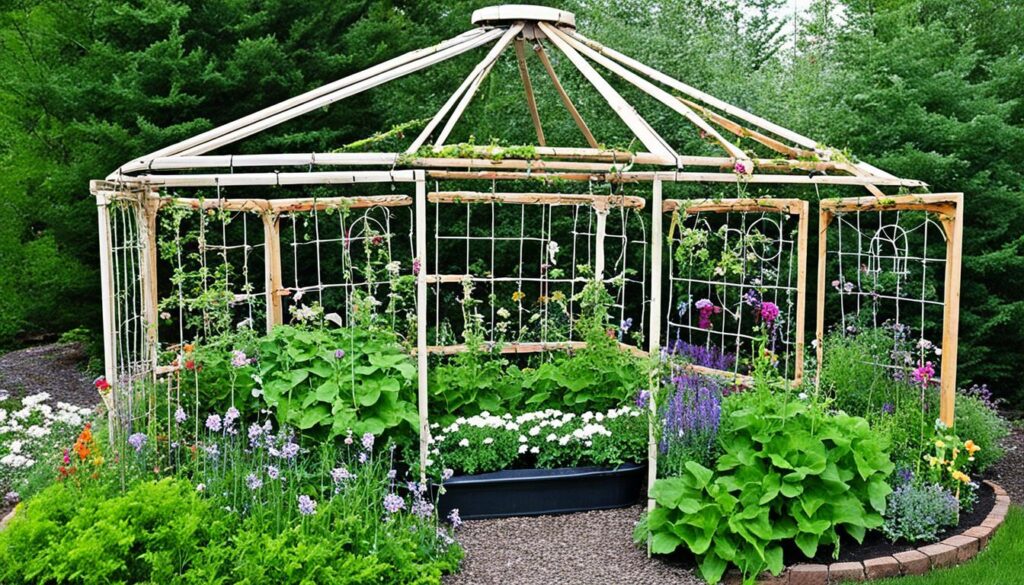
Get creative and see what you can do with upcycled garden structures. From garden trellises to DIY projects, there are many options. By using old items, you can make your garden look better and save money.
| Upcycled Garden Structure | Repurposed Material | Functionality |
|---|---|---|
| Vertical Trellis | Old Ladder | Support for vining plants, display trailing flowers |
| Tiered Planter | Salvaged Wooden Pallet | Increase growing space, add visual interest |
| Garden Wall | Reclaimed Wood | Divide garden areas, provide privacy, grow plants vertically |
Upcycling lets you turn your garden into a special place that shows off your style and care for the planet. Enjoy making upcycled garden structures that make your garden look and work better.
Homemade Garden Projects for Outdoor Living
Turn your outdoor areas into a part of your home with DIY garden projects. Create custom benches or portable potting stations. These projects mix style with function, making your garden look and feel better. Enjoy making unique items that make your outdoor space more comfortable and fun.
Make a cozy DIY garden bench with reclaimed wood or recycled stuff. It adds a personal feel to your patio or garden. Or, build a handy potting station for easy gardening work and storage.
- Build a rustic outdoor bar with pallets or salvaged items. It turns your backyard into a great spot for gatherings.
- Design a cute birdhouse or bird feeder to draw birds and add fun to your garden.
- Make a plant stand or vertical garden to use space well and show off your plants.
These DIY garden projects make your outdoor spaces look better and show off your style and creativity. Pick projects that match your interests and turn your backyard into a place of comfort and happiness.
“Gardening is the art of growing plants. DIY gardening is the art of growing happiness.” – Unknown
DIY Garden Projects for a Personal Touch
Add a personal touch to your garden with DIY projects that show off your style. You can make a customized garden sign or whimsical yard art. These projects let you add a special and meaningful part to your outdoor space.
Crafting Unique Pieces that Reflect Your Style
Let your creativity flow and make personalized garden decor that shows your unique style. You can paint garden stones or make bird feeders from old items. Use things like old picture frames or ceramic pieces to create unique garden projects. These add charm and personality to your garden.
“The true essence of gardening lies in the ability to infuse your personal touch and create a space that is uniquely your own.”
Working on these DIY garden projects improves your garden’s look and deepens your bond with it. A handmade garden sign or a sculpture from recycled materials makes your garden stand out.
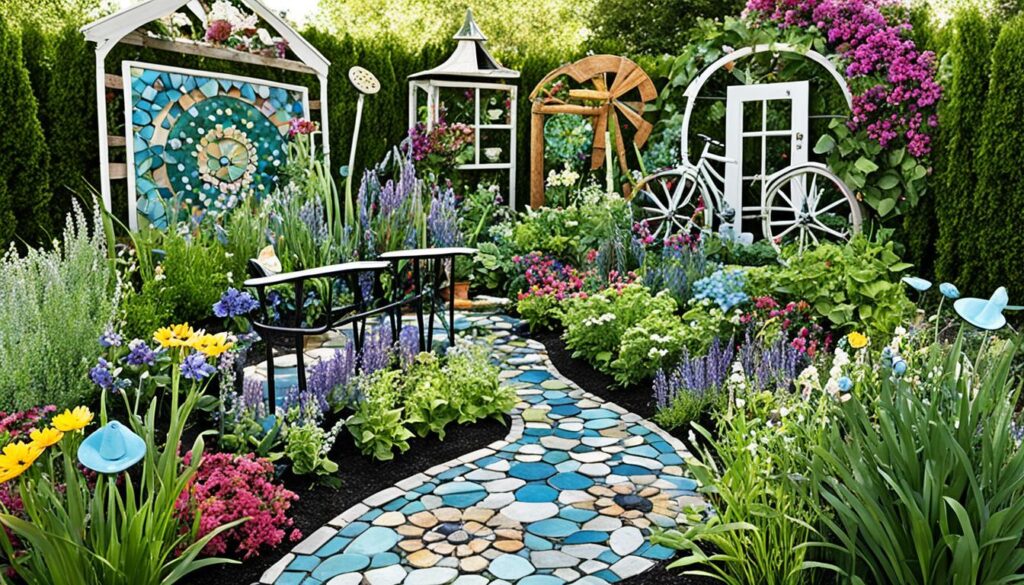
Enjoy the fun of DIY garden art and let your creativity show. With imagination and basic crafting skills, you can turn your garden into a reflection of your unique style and personality.
Eco-Friendly DIY: Reducing Garden Waste
We all need to use sustainable practices to lessen our impact on the planet. One great way is by doing DIY projects that cut down on garden waste. These projects help the environment and make your garden feel more personal.
Begin by repurposing discarded items into garden decorations. You can use old tires, wooden pallets, and broken ceramics to make planters, trellises, and art. This way, you reduce waste and add a special touch to your garden.
Another good idea is to embrace composting. This process turns organic stuff into nutrient-rich soil for your plants, cutting down on synthetic fertilizers. Set up a compost bin or pile in your garden with kitchen scraps and yard waste. This creates a healthy, eco-friendly gardening environment.
- Upcycle discarded items into unique garden decor
- Compost kitchen scraps and yard waste to nourish your plants
- Explore sustainable DIY projects that minimize garden waste
By using these eco-friendly gardening methods, you’ll make your garden look better and help the planet. Get creative and enjoy the benefits of reducing garden waste with DIY projects.
Garden Planning: Designing Your Dream Oasis
Let your creativity flow and turn your outdoor area into a beautiful garden oasis. Use DIY elements to make it happen. Whether you want a practical layout or a magical design, good garden planning is essential.
Incorporating Functional and Decorative DIY Elements
When designing your dream garden, mix practical and pretty DIY garden projects. Think about adding custom-built features like raised beds, trellises, and places to store things. These can make your garden work better and look great.
At the same time, add unique garden decor made from old items and your own creations. This will make your garden stand out with its own special touch.
Plan your garden well and pick DIY elements that fit your gardening needs. This way, you’ll have a beautiful and useful outdoor space that shows off your style.
“The key to a beautiful and functional garden is in the planning. Embrace your creativity and let your DIY spirit shine!”
- Look at your space and see where you can use it best for looks and function
- Find new uses for everyday items in your garden decor
- Add green and sustainable touches, like old planters or homemade compost bins
- Play with different textures, colors, and shapes for a garden that catches the eye
- Choose both useful and decorative DIY projects for the best look in your garden
With the fun of DIY gardening, you can make your outdoor area truly yours. It will show off your style and be a functional and decorative garden you’ll love for a long time.
Conclusion: Embrace the Joy of DIY Gardening
As you’ve seen, DIY gardening opens up endless possibilities. It’s time to dive into the joy and fulfillment it brings. You can turn everyday items into unique garden pieces, make eco-friendly planters, or design a garden that’s all your own.
Let your creativity run wild as you make your outdoor space show off your style and values. Learn about sustainable gardening, grow your own food, and see your garden become a peaceful place. DIY gardening is more than just making things; it’s about connecting with nature and feeling proud of what you’ve done.
Start your DIY gardening journey and let your garden show off your unique style. It doesn’t matter if you’re new to gardening or have been doing it for years. The joy of DIY gardening is waiting for you. Get creative, explore new ideas, and watch your garden become a true reflection of your passions and personality.
FAQ
What types of upcycled projects can I create for my garden?
You can turn everyday items like thrift store finds and metal magazine racks into garden decorations. Use your creativity to make decorative garden stones, bird baths, and planters. This way, you can make your garden stand out with unique art pieces.
How can I incorporate sustainable practices into my DIY garden projects?
Use recycled materials like concrete and old furniture to make your own planters. These eco-friendly planters are both beautiful and good for the planet. They help reduce your garden’s environmental impact.
What kind of whimsical DIY crafts can I add to my garden?
Add a touch of magic to your garden with quirky art and charming accents. These projects will make your outdoor space more enchanting. They bring a sense of wonder and imagination to your garden.
How can I enhance the functionality and productivity of my garden through DIY projects?
Build custom trellises and raised beds to make the most of your garden space. These DIY projects help you garden more efficiently. They make your garden organized and easy to maintain.
What organic practices and techniques can I incorporate into my DIY garden projects?
Learn to make your own pest repellents and start composting. These organic methods help your garden thrive while being kind to the environment.
How can I use upcycled materials to create trellises and supports for my garden?
Turn old gardening tools or furniture into unique trellises and supports. These upcycled structures are strong and add a personal touch to your garden.
What type of homemade garden projects can enhance my outdoor living spaces?
Build custom benches and portable potting stations to improve your garden. These DIY projects make your garden more beautiful and useful. They turn your garden into an extension of your home.
How can I add a personal touch to my garden with DIY projects?
Make your own garden sign or yard art to give your garden a unique feel. These DIY projects add a special touch to your outdoor space.
What eco-friendly DIY projects can I incorporate into my gardening efforts?
Use old items to make garden accents and try composting to feed your plants. These eco-friendly projects help your garden stay healthy and green.
How can I plan and incorporate a variety of DIY elements into my garden?
Plan your garden carefully to include both practical and decorative DIY elements. Use custom-built structures for efficiency and whimsical pieces for personality. This way, you can create a beautiful and functional garden.
Source Links
- https://www.sadieseasongoods.com/20-fun-functional-garden-decor-project-ideas/ – Garden Decor Ideas that are Upcycled and Repurposed
- https://www.houseofhawthornes.com/cheap-diy-garden-projects/ – DIY Garden Projects On A Budget
- https://www.hometalk.com/diy/outdoor/garden – DIY Outdoor Garden Ideas
Organic Weed Control: Natural Methods for a Weed-Free Garden
Are you tired of fighting weeds in your garden? There’s hope! With organic methods, you can control weeds and have a beautiful garden. We’ll show you natural ways to make your garden weed-free.
Weeds might seem bad, but they’re actually good for your garden. They help with soil health and attract good insects. This balance is key for a healthy garden.
We’ll share the best ways to stop weeds and keep your garden looking great. Learn about timing, identifying weeds, and using no-till farming and mulching. These methods help you have a garden without chemicals.
Ready to use organic weed control and make your dream garden? Let’s start and learn how to keep your garden weed-free and thriving!
Key Takeaways
- Discover the hidden benefits of weeds and how to harness them for your garden’s benefit.
- Learn effective strategies for preventing weed growth, including timing, identification, and innovative techniques.
- Explore natural, organic methods for controlling weeds, such as mulching, cultivation, and targeted organic treatments.
- Understand the importance of protecting soil health and how it can contribute to a weed-free garden.
- Gain the knowledge and confidence to create a sustainable, thriving outdoor space without relying on harmful chemicals.
Understanding Weeds: A Shift in Perspective
Exploring organic weed control means changing how we see weeds. Some weeds can be a problem, but many have great benefits. They help the soil, feed pollinators, and are part of the garden’s balance.
Learning about different weeds helps you decide which to keep or remove. This approach makes gardening more sustainable and balanced.
The Benefits of Weeds
Weeds can be good for your garden. Many are edible and add nutrition to your meals. Purslane is full of omega-3 fatty acids, vitamins, and antioxidants.
Dandelions are rich in vitamins A, C, and K, plus iron and calcium. Embracing these weeds means less waste and a more diverse garden.
Gaining Respect for Weeds
Respecting nature and managing weeds well means understanding them. Knowing the weeds in your garden helps you decide which to keep or remove. This knowledge lets you work with weeds, not against them.
On your journey to control weeds organically, see weeds as part of the garden, not just unwanted plants. They play a key role in the ecosystem. By valuing weeds, we can create a garden that works with nature.
Preventing Weed Growth: The Importance of Timing
Keeping your garden weed-free is a constant challenge. But, timing is everything. To prevent weeds, you must act before they can spread. This means stopping them from seeding early on. By doing so, you can break the weed cycle and keep your garden healthy with organic practices.
Getting to the Weeds Before They Seed
Removing weeds before they seed is key to stopping their growth. This means watching your garden closely and pulling weeds regularly. It’s a vital step to keep your garden weed-free without harsh chemicals. By controlling weeds early, you’ll reduce the number of seeds in your soil, making future control easier.
Identifying Weeds: Knowledge is Power
Knowing which weeds you have is crucial for controlling them organically. Different weeds need different treatments, and some can even be beneficial. Learn the names and traits of your garden weeds through online resources, local offices, or field guides. This knowledge lets you decide which weeds to remove and how to manage them. Understanding your weeds is a key part of a sustainable, organic garden.
“If you allow weeds to mature and drop their seeds, you’ll be dealing with the consequences for years to come, as the weed seed bank in your soil will continue to germinate.”
No-Till Approach: Protecting Soil Health
Avoiding tillage is key to controlling weeds organically in your garden. Tillage can harm the soil’s microbial systems and structure. This leads to compaction, low organic matter, and weed seeds germinating. By choosing no-till gardening, you stop millions of weed seeds from growing.
Using no-till practices keeps your soil healthy and supports organic gardening. This method creates a strong, eco-friendly ecosystem in your garden.
| Benefits of No-Till Gardening | Drawbacks of Tillage |
|---|---|
|
|
Choosing no-till gardening helps protect your soil’s balance. It makes your garden thrive and follow organic and sustainable gardening principles.
“Healthy soil is the foundation for successful, sustainable gardening. By avoiding tillage, we can nurture the soil’s natural processes and create an environment that is inhospitable to weeds while promoting the growth of our desired plants.”
Mulching: A Powerful Weed Suppression Technique
Putting a thick layer of organic mulch is a top way to stop weeds in your garden. Mulch acts as a barrier, blocking light and stopping weed seeds from growing. As it breaks down, it also makes your garden soil healthier and more fertile.
Types of Organic Mulches
Some top organic mulch choices for fighting weeds and improving soil are:
- Shredded leaves
- Straw
- Wood chips
- Compost
These natural materials not only kill weeds but also keep soil moist and add important organic stuff to your garden.
Tips for Effective Mulching
To get the most out of organic mulches, follow these important tips:
- Put the mulch on early in the season, before weed seeds can start growing.
- Clear out any weeds before putting on the mulch, as it won’t kill plants that are already there.
- Use a thick layer, about 2-3 inches, to block sunlight and stop weeds from growing.
- Don’t use dyed or treated mulches, or straw that might have weed seeds.
By doing these things, you can make a strong, lasting mulch barrier. This will help keep your garden weed-free and your soil healthy and thriving.
“Mulching is a game-changer for your garden. It’s an effortless way to suppress weeds and nourish your soil at the same time.”
Organic Weed Control: Natural Methods for a Weed-Free Garden
Keeping your garden weed-free doesn’t need harsh chemicals. Using organic weed control methods, you can keep your garden healthy and weed-free. This approach uses many strategies to manage weeds.
Mulching is a strong way to control weeds. Organic mulches like wood chips or straw block light and stop weeds from growing. They also help keep the soil healthy and moist, which is good for sustainable gardening.
Paper mulches, such as cardboard, are another good option. They smother weeds and add organic matter to the soil as they break down. This method helps control weeds and improves your garden maintenance work.
Cultivation and topping are also effective. Loosening the soil harms weed roots, and cutting off weed flowers stops them from spreading.
For tough weeds, try tarping or flame weeding. Tarping cuts off light and oxygen, killing weeds. Flame weeding burns weeds without hurting the soil.
Using these natural weed prevention methods keeps your garden weed-free and healthy. Stay proactive and committed to sustainable gardening for a beautiful garden.
Paper Mulches: Layering for Success
Organic gardeners use paper mulches to keep their gardens weed-free. They put cardboard or thick builder’s paper on the soil, then add organic mulch on top. This creates a strong barrier that stops weeds from growing.
Using Cardboard and Builder’s Paper
The paper slowly breaks down, adding nutrients to the soil. At the same time, the organic mulch keeps the area weed-free. This method, known as “sheet mulching,” is great for starting new beds or improving old ones. Using paper mulches boosts your organic gardening efforts and helps you have a lush, weed-suppressed garden.
- Cardboard effectively blocks light and suppresses weed growth.
- Builder’s paper, with its added thickness, offers even more weed suppression power.
- The paper materials gradually decompose, enriching the soil with valuable nutrients.
- Topping the paper layer with organic mulches maintains the weed-free environment.
Try layering paper mulches in your organic gardening to see amazing results. Enjoy a beautiful, weed-free garden oasis.
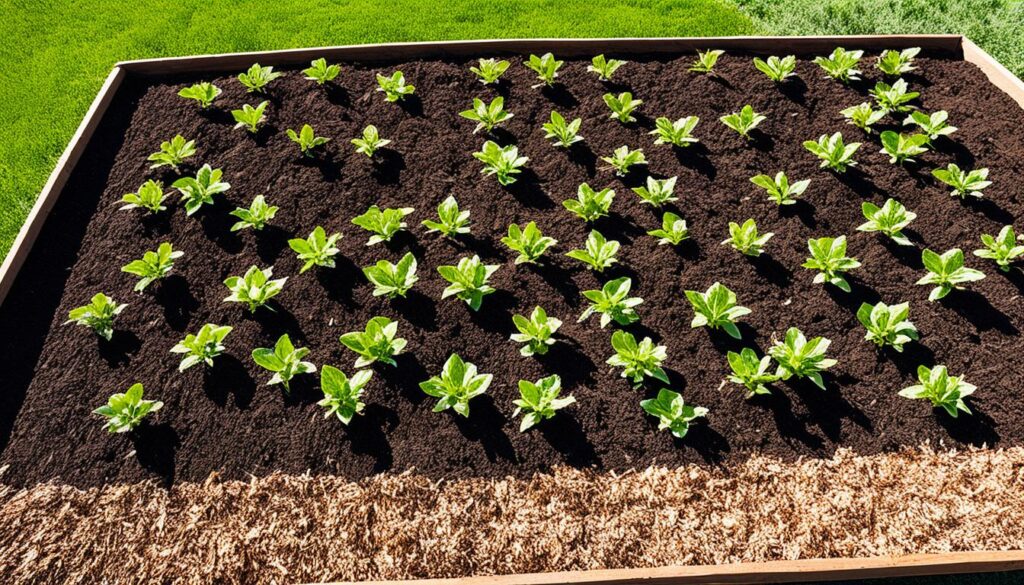
“Paper mulches provide a dual benefit – they suppress weeds while also improving soil health as they break down over time.”
Cultivation and Topping: Old-School Techniques
Modern organic gardening methods work great, but old-school techniques are also useful. Careful cultivation of the soil helps remove young weed seedlings before they spread.
Tools like hoes and scuffles can disrupt weeds by loosening the soil. This exposes their roots to the sun and air. This simple method works well with other organic strategies like mulching and watching for weed seeds.
Topping, or cutting off weed flowers and seed heads, is another traditional method. It stops them from dropping seeds, reducing the weed seed bank in your garden. This makes it harder for weeds to grow back.
- Carefully cultivate the soil to remove young weed seedlings
- Use tools like hoes and scuffles to disrupt weeds
- Cut off weed flowers and seed heads before they drop seeds (topping)
Using these old-school methods with other organic weed control strategies keeps your garden healthy. You won’t need synthetic chemicals. The goal is to create a weed-free garden oasis.
Additional Organic Weed Control Strategies
Keeping your garden weed-free is key to a healthy garden. Exploring different organic weed control methods is essential. Compost monitoring and tarping for persistent weeds are two effective strategies.
Compost Monitoring
When using homemade compost in your garden, watch it closely. Don’t add weeds that have seeds, as they might not get killed by the compost heat. Turning and checking the compost pile often ensures it gets hot enough to kill weed seeds. This way, you can use the compost safely without spreading weeds.
Tarping for Persistent Weeds
Tarping is great for tough, perennial weeds. Cut the weeds down, then cover the area with a dark tarp and secure it. This method blocks light and oxygen, slowly killing the roots over time. Though it should be used carefully, as it affects soil life too, tarping can effectively get rid of weeds in your garden.
Flame Weeding
Flame weeding uses a propane torch to kill weeds. The heat bursts the plant cells, killing them off, especially annual weeds and those in cracks or along fences. It’s a spot treatment that’s fun and chemical-free. But, be careful not to harm the plants you want to keep.
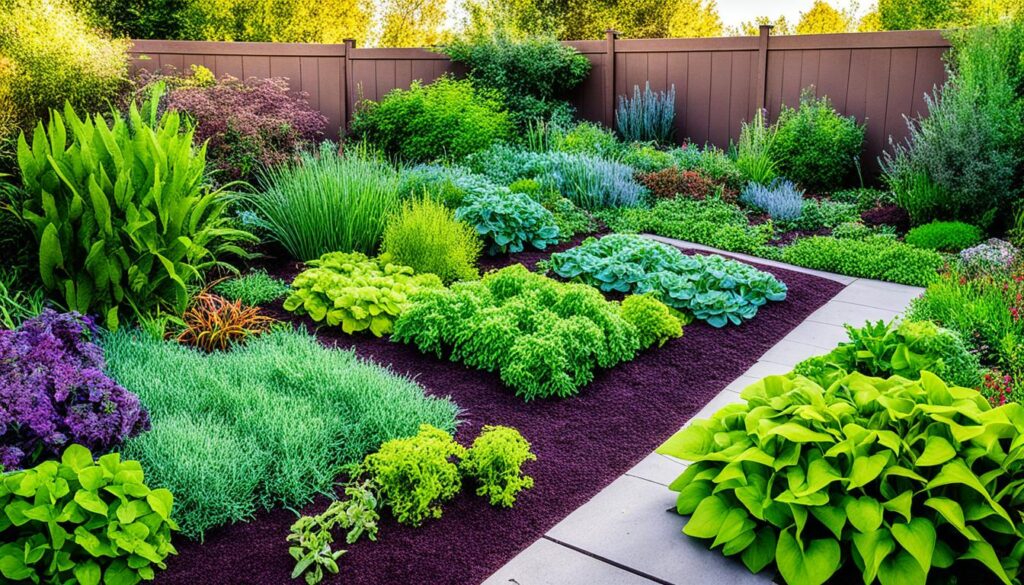
Adding these organic weed control methods to your garden care can keep your garden weed-free and healthy.
Conclusion
Using a mix of organic weed control methods, you can keep your garden weed-free without harmful chemicals. This guide has shown you how to prevent weeds and use techniques like mulching and cultivation. You now have the tools and knowledge to take back your outdoor space.
Choosing a sustainable way to manage weeds helps your garden be healthy and productive. It also supports a balanced ecosystem. With patience and persistence, you can have a garden that’s beautiful and weed-free. Using organic methods makes your garden look great and helps the environment too.
On your path to a weed-free garden, remember that organic weed control is ongoing. You need to watch your garden closely and try different methods. With this guide, you’re ready to keep your garden looking great with organic weed control, sustainable gardening, and garden maintenance.
FAQ
What are the benefits of weeds in the garden?
Some weeds can make the soil richer and help pollinators. They can also be eaten by humans. Learning about weeds is key to managing them well.
How can I prevent weeds from going to seed in my garden?
Pulling weeds before they spread their seeds is important. This keeps your garden weed-free without harsh chemicals. It takes regular care and attention.
Why is identifying weeds important for organic weed control?
Knowing your weeds lets you decide which to remove or leave. This knowledge helps you control weeds in a green way. It’s essential for a healthy garden.
How does a no-till approach benefit my garden’s weed control?
No-till stops weed seeds from growing. It keeps your soil healthy and fights weeds. This method is key to a weed-free garden.
What are the best organic mulch options for weed control?
Good mulch choices include shredded leaves, straw, wood chips, and compost. They stop weeds and make your soil better.
How can paper-based materials help control weeds in my garden?
Cardboard or builder’s paper layered on the soil blocks light and stops weeds. Adding organic mulch on top makes a strong weed barrier. This method is called “sheet mulching.”
What are some old-school techniques that can help control weeds organically?
Use tools like hoes and scuffles to remove young weeds. Cutting off weed flowers and seed heads also reduces weed seeds. These methods work well.
How can I prevent weed seeds from being introduced through homemade compost?
Don’t add weeds with seeds to your compost. Turn the pile often to make sure it gets hot enough to kill seeds.
When is tarping an effective organic control method for persistent weeds?
Tarping works well on tough weeds. Cover the area with a tarp to block light and oxygen. This slowly kills the roots over time.
How can flame weeding be used as an organic weed control technique?
Flame weeding uses a torch to kill weeds by bursting their cells. It’s great for spot treatments and controlling annual weeds in specific areas.
Source Links
- https://www.heirloomsoul.com/blog/how-to-suppress-weeds-organically-without-chemicals – Methods for Organic Weed Control — Heirloom Soul Florals
- https://savvygardening.com/organic-weed-control-tips/ – Organic weed control tips for gardeners
- https://www.theprairiehomestead.com/2019/07/natural-weed-control.html – Natural Weed Control for Your Garden • The Prairie Homestead
- 10 Must-Have Blooms for Your 2025 Garden
- The Health Advantages of Gardening You Need to Know
- How to Create a Small Vegetable Garden Layout Plan: A Beginner’s Guide
- DIY Garden Projects for Small Spaces: Upcycling Ideas to Maximize Your Garden
- Watering Techniques for Small Gardens: Ensuring Your Plants Thrive
- Small Border Plants for Landscaping: Adding Beauty and Functionality to Your Garden
- Year-Round Small Space Gardening: Seasonal Planting Tips for Maximum Harvest
- Essential Tools for Small-Space Gardening: What You Really Need
- The Ultimate Guide to Container Vegetables: What to Grow in Small Spaces
- Budget-Friendly Gardening: How to Create a Thriving Garden on a Tight Budget
- How to Optimize Sunlight in Small Gardens: Tips for Better Plant Growth
- DIY Vertical Planters: Creative Ideas for Small Space Gardening
- Companion Planting for Small Vegetable Gardens: Boost Growth and Deter Pests
- Container Gardening Essentials: Choosing the Right Pots, Soil, and Plants
- Vertical Gardening Techniques: Maximizing Your Small Space with Climbers and Vines
- How to Build a Raised Bed Garden in a Small Backyard: Step-by-Step Guide
- The Best Vegetables for Small-Space Gardens: High-Yield Varieties You Need to Grow
- Smart Vegetable Garden Layouts for Small Spaces: Maximizing Your Green Thumb in Compact Areas
- 40. Best Practices for Managing a Sustainable Garden Year-Round
- Building a Wildlife Pond for Biodiversity
- Advanced Techniques in Sustainable Gardening
- How to Create a No-Till Garden
- The Mental Health Benefits of Gardening
- Using Technology to Enhance Sustainable Gardening
- Getting Certified Organic: Steps and Benefits
